#including policing their views on the conflict or the existence of israel
Explore tagged Tumblr posts
Text
People who want to do activism but are not directly affected by I/P in a personal sense (meaning they are not in either Israel or Palestine or have family that is, and are not Muslim or Jewish) should read the words of those on both sides of the Gaza conflict.
#if you cant figure out why then i cannot help you#but i strongly believe the first thing you have to do in order to build a better world that espouses leftist values#is to see EVERYONE as human#before you as an outsider write a super polarising screed- do this#and remember that if you do not live in the affected region your number 1 duty as an activist#should be to not increase hatred towards diaspora muslims or jews in any way#including policing their views on the conflict or the existence of israel
0 notes
Text
courting antisemitism
so i recently decided to take a look at the latest stonetoss comics (probably because i love suffering). and while i was expecting some content on the israel palestine conflict, what i did not expect was how... standard it seemed. well, most of it at least, but i'll get to that in a second.
for context, if you don't know what stonetoss is, it's a (poorly drawn) webcomic known for having radical alt-right views - meaning it's incredibly racist, homophobic, transphobic, islamophobic, antisemitic. all that fun stuff.
so while i was expecting to see bad stuff, one of the first things i saw on the topic of israel was this:
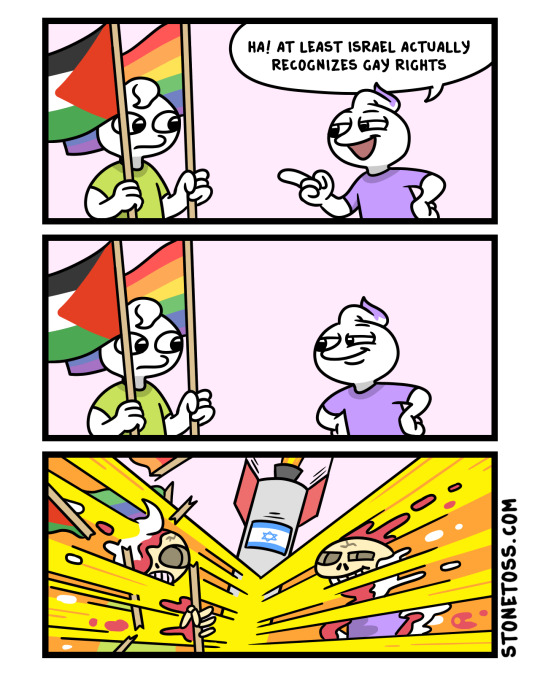
terrible art aside, this comic is making a point that i usually see in left wing circles: that israel is pinkwashing genocide.
curious if there was more like this, i kept looking, and the comic right before that one was this:

again, this makes points that i usually see in left wing circles. that american healthcare is crazy expensive, that canada tells poor people to commit suicide, and that israel is bombing hospitals.
why does stonetoss, this well known alt-right nutjob, now seem to be bringing up left-wing talking points?
curious, i kept going deeper:

well this is... odd. clearly, stonetoss is trying to say that israel is on another level of bad, even worse than russia, iran, and north korea. i can possibly see someone on the left making the argument that the russian invasion of ukraine isn't as bad as what israel is doing in gaza, or that at least north korea isn't invading any other countries, but... iran??? the country that has a police force designed to enforce religious law, and gets away with murdering women who do not properly cover their hair? the country that props up paramilitary groups in countries all over the middle east, including lebanon, yemen, and yes, palestine?? that's completely ridiculous
but, given how much more israel is in the news nowadays than any of these other countries, i could see why someone would buy this
and now, we're starting to get to the crux of what stonetoss is trying to do. when someone sees this, they might be inclined to agree with it. they might begin to think that israel is the worst country on the planet
and that might not seem so bad at first. but the more you hate israel, especially irrationally, the more you feel allowed to dehumanize those who support it. the more you might be willing to agree with this comic, which came out two days prior to the one above
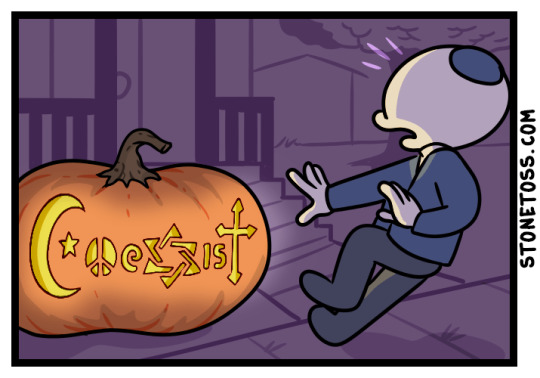
this comic says that jews, as a whole have no desire to exist with other people. it is blatantly antisemitic
i'm sure you could imagine some young leftist who sees the comics above this one and thinks, "this guy makes some good points". and then, when they get to this one, they might realize that this is antisemitism
or, they may not.
and that would start them down the road to becoming an antisemite.
this is what stonetoss and other alt-right nutjobs are hoping to achieve. to take left wing fury at israel, and direct it at jews.
we saw it with those neo-nazis at the palestine rally, and we're seeing it again here.
and if you've found yourself agreeing with what stonetoss has said so far, i would like you to see the last comic stonetoss put out before october 7th:

this horrifically racist comic is in reference to an environmental activist who was murdered by a black man in early october. this blatantly racist garbage is the kind of stuff stonetoss usually puts out.
but as soon as october 7th happened? these were his next two comics:
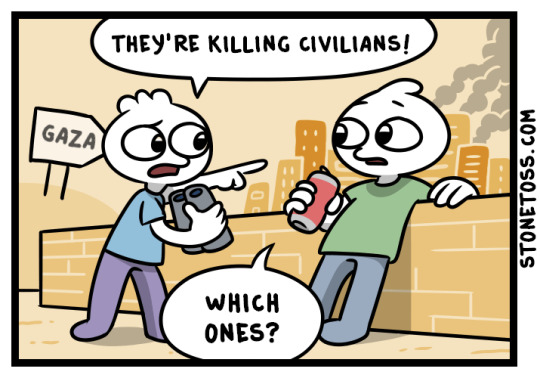
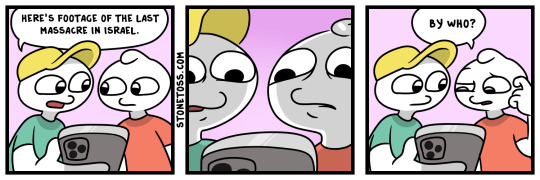
stonetoss completely changed the comic's tone as soon as the current crisis started. why?
to get as many people as possible to get on board with hating jews.
and i know many of you might be thinking that "well, everyone knows that stonetoss is racist garbage. nobody is going to fall for this"
except, as we saw with the neo-nazis at the rally for palestine, it's not always that obvious who the antisemites are and who is just rallying for peace. they are often a lot better at disguising it than stonetoss is.
AND EVERYONE NEEDS TO BE AWARE OF THAT
EVERYONE, no matter HOW much experience you have, can fall victim to propoganda. EVERYONE needs to be aware of what people around them are saying, and able to pick out hateful rhetoric, because even the stuff that is just kind of toeing the line of what's hateful is still putting your foot in the door
be cautious, everyone. and stomp out hate where you see it.
10K notes
·
View notes
Text

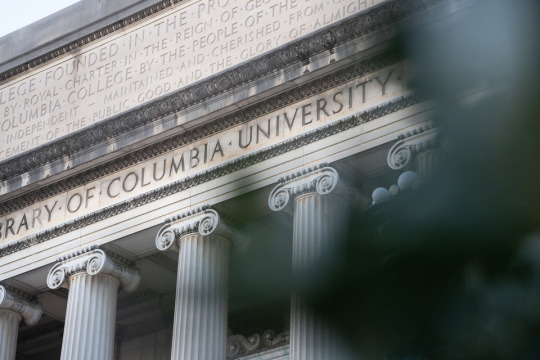
Dear President Shafik,
We write as Jewish faculty of Columbia and Barnard in anticipation of your appearance before the House Committee on Education and the Workforce on April 17, where you are expected to answer questions about antisemitism on campus. Based on the committee’s previous hearings, we are gravely concerned about the false narratives that frame these proceedings to entrap witnesses. We urge you, as the University president, to defend our shared commitment to universities as sites of learning, critical thinking, and knowledge production against this new McCarthyism.
Rather than being concerned with the safety and well-being of Jewish students on campuses, the committee is leveraging antisemitism in a wider effort to caricature and demonize universities as hotbeds of “woke indoctrination.” Its opportunistic use of antisemitism in a moment of crisis is expanding and strengthening longstanding efforts to undermine educational institutions. After launching attacks on public universities from Florida to South Dakota, this campaign has opened a new front against private institutions.
The prospect of Rep. Elise Stefanik, a member of congress with a history of espousing white nationalist politics, calling university presidents to account for alleged antisemitism on their campuses reveals these proceedings as disingenuous political theater.
In the face of these coordinated attacks on higher education, universities must insist on their freedom to research and teach inconvenient truths. This includes historical injustices and the contemporary structures that perpetuate them, regardless of whether these facts are politically inexpedient for certain interest groups.
To be sure, antisemitism is a grave concern that should be scrutinized alongside racism, sexism, Islamophobia, homophobia, and all other forms of hate. These hateful ideologies exist everywhere and we would be ignorant to believe that they don’t exist at Columbia. When antisemitism rears its head, it should be swiftly denounced, and its perpetrators held to account. However, it is absurd to claim that antisemitism—“discrimination, prejudice, hostility or violence against Jews as Jews,” according to the Jerusalem Declaration’s definition—is rampant on Columbia’s campus. To argue that taking a stand against Israel’s war on Gaza is antisemitic is to pervert the meaning of the term.
Labeling pro-Palestinian expression as anti-Jewish hate speech requires a dangerous and false conflation of Zionism with Jewishness, of political ideology with identity. This conflation betrays a woefully inaccurate understanding—and disingenuous misrepresentation—of Jewish history, identity, and politics. It erases more than a century of debates among Jews themselves about the nature of a Jewish homeland in the biblical Land of Israel, including Israel’s status as a Jewish nation-state. It dismisses the experiences of the post-Zionist, non-Zionist, and anti-Zionist Jews who work, study, and live on our campus.
The political passions that arise from conflict in the Middle East may deeply unsettle students, faculty, and staff with opposing views. But feeling uncomfortable is not the same thing as being threatened or discriminated against. Free expression, which is fundamental to both academic inquiry and democracy, necessarily entails exposure to views that may be deeply disconcerting. We can support students who feel real and valid discomfort toward protests advocating for Palestinian liberation while also stating clearly and firmly that this discomfort is not an issue of safety.
As faculty, we dedicate ourselves and our classrooms to keeping every student safe from real harm, harassment, and discrimination. We commit to helping them learn to experience discomfort and even confrontation as part of the process of skill and knowledge acquisition—and to help them realize that ideas we oppose can be contested without being suppressed.
By exacting discipline, inviting police presence, and broadly surveilling its students for minor offenses, the University is betraying its educational mission. It has pursued drastic measures against students, including disciplinary proceedings and probation, for infractions like allegedly attending an unauthorized protest, or moving barricades to drape a flag on a statue. Real harassment and physical intimidation and violence on campus must be confronted seriously and its perpetrators held accountable. At the same time, the University should refrain whenever possible from using discipline and surveillance as means of addressing less serious harms, and should never use punitive measures to address conflicts over ideas and the feelings of discomfort that result. Where the University once embraced and defended students’ political expression, it now suppresses and disciplines it.
The University’s recent policies represent a dramatic change from historical practice, and the consequences are ruinous to our community and its principles. In the past, Columbia has periodically confronted attacks against pro-Palestinian speech, ranging from the vile slanders against Professor Edward Said to the reckless accusations from the David Project. But where for decades the University stood firm against smear campaigns targeting its professors, it has now voluntarily accepted the job of censoring its faculty in and outside the classroom.
Columbia’s commitment to free inquiry and robust disagreement is what makes it a world-class institution. Limiting academic freedom when it comes to questions of Israel and Palestine paves the way for limitations on other contested topics, from climate science to the history of slavery. What’s more, students must have the freedom to dissent, to make mistakes, to offend without intent, and to learn to repair harm done if necessary. Free expression is not only crucial to student development and education outside the classroom; the tradition of student protest has also played a vital role in American democracy. Columbia should be proud of having participated in nationwide student organizing that helped secure civil rights and reproductive rights and helped bring an end to the Vietnam War and apartheid in South Africa.
We express our support for the University and for higher education against the attacks likely to be leveled against them at the upcoming congressional hearing. We object to the weaponization of antisemitism. And we advocate for a campus where all students, Jewish, Palestinian, and all others, can learn and thrive in a climate of open, honest inquiry and rigorous debate.
Many members of our University community share our perspective, but they have not yet been heard. Columbia students, staff, alumni, and faculty can sign here to show your support for this letter’s message.
—Jewish faculty reject the weaponization of antisemitism
The 23 authors of this letter are Jewish faculty members of Barnard College and Columbia University. This letter derives from a much longer one by these same 23 faculty sent to President Shafik on April 5.
#politics#palestine#israel#columbia university#antisemitism#anti zionisim#antizionism#weaponized antisemitism#minouche shafik#anti zionism ≠ antisemitism#zionism#rafah#gaza#white supremacy#racism#barnard college#protests#israel is a terrorist state#war crimes#ethnic cleansing#weaponized identity politics#colonialism#imperialism#student protests#human rights#human rights violations#bds#boycott divest sanction#hasbara#idpol
87 notes
·
View notes
Text
The article under the link:
German leaders denounce US artist's fiery Israel speech
Photographer Nan Goldin denounced what she called Israel's "genocide in Gaza and Lebanon." She was in Berlin for the opening of a retrospective about her life's work.
American photographer, artist and activist Nan Goldin has caused outrage with a speech in Germany accusing Israel of "genocide in its conflicts in Gaza and Lebanon." Goldin, who is of Jewish origin and among the most renowned artists in contemporary photography, also used the opening of her exhibition at the Neue Nationalgalerie in Berlin on Friday to say that criticism of Israel doesn't equate to antisemitism. German cultural leaders criticized Nan Goldin's speech for being one-sided but emphasized the importance of free expression and dialogue. What did Nan Goldin say? The 71-year-old Goldin began her almost 14-minute speech with four minutes of silence to remember victims of the conflict in the Palestinian territories and Lebanon, as well as civilians killed in Israel. The gallery's lifetime retrospective of Goldin, entitled "This Will Not End Well," showcases a comprehensive overview of her work, including slideshows and films, backed by music. "I have decided to use this exhibition as a platform to amplify my position of moral outrage at the genocide in Gaza and Lebanon," Goldin then told the audience. Her comments were made a day after the International Criminal Court in The Hague issued arrest warrants for Israeli Prime Minister Benjamin Netanyahu and former Israeli Defense Minister Yoav Gallant on suspicion of war crimes and crimes against humanity. "My grandparents escaped pogroms in Russia. I was brought up knowing about the Nazi Holocaust. What I see in Gaza reminds me of the pogroms that my grandparents escaped," she said. How have German-Israeli ties changed since Oct. 7 attacks? "Never again means never again for everyone," Goldin added, referring to a phrase used by Germans as a key lesson of the Holocaust during World War II in which 6 million Jews were killed. "What have you learned, Germany?" Goldin continued, attacking the country's handling of pro-Palestinian protests during the war. She also spoke up about the treatment of artists and others who expressed harsh criticism of Israel, who have had exhibitions in Germany canceled or dealt with other repercussions. Criticism of Israel has been conflated with antisemitism," Goldin said, adding that, "Anti-Zionism has nothing to do with antisemitism." She then alleged that Islamophobia was being ignored in Germany, saying that the country is the "home of the largest Palestinian diaspora in Europe. Yet protests are met with police dogs and deportation and stigmatization." she said. Goldin walked off the stage to loud chants of "free, free Palestine." The crowd chanted "Free Palestine" during a subsequent speech by the museum's director Klaus Biesenbach Speech criticized by politicians and cultural leaders Museum director Klaus Biesenbach gave a speech after Goldin, defending Israel's right to exist, arguing the conflict started with the October 7, 2023 attack by Hamas on Israel, but he also called for sympathy toward the suffering of the civilian population in Gaza. Biesenbach later released a statement, saying the gallery distanced itself from the protesters' stance, adding that it "stands for freedom of expression and respectful dialogue and interaction with each other." German Culture Minister Claudia Roth denounced Goldin for her "unbearably one-sided political views" and said she was "appalled" at the way people in the audience chanted slogans like "Free Palestine." But Roth rejected calls for a boycott of an upcoming symposium and said she hoped for an open and civilized debate. The culture minister of Berlin state, Joe Chialo, also accused Goldin of "one-sidedness" and "obliviousness to history" with her remarks in Berlin, "the city in which the Holocaust was planned." Hermann Parzinger, the president of the Prussian Cultural Heritage Foundation, also sharply denounced Goldin's talk. "This does not correspond to our understanding of freedom of expression," he said.
Here's the full speach of Nan Goldin with English and German subtitles on Instagram:
instagram
Few quotes:
"never again means never again for everyone"
"because advocating for human rights cannot be antisemitic"
German leaders denounce US artist's fiery Israel speech – DW – 11/23/2024
Antiszemita/anticionista zsidó. Elásta magát libernyák körökben, mehet vissza ugrálni a balettba
#Instagram#now how the fuck is THIS one-sidedness!?!#how is crying to not let thousands of children starve to death die a 'one-sidedness'?#how is asking to imagine throwing 2000 bombs on New York because of terrorist hiding in its tunnels a 'one-sidednes'?#in other words - to not be 'one-sided' you'd practically have to say:#''yes this is a cold-blood murder of masses of innocent people BUT Isreal goverment also have their reasons...'' - right?#thus actually agreeing that yes this IS genocide but you're just shaking your ass so bad not to be called ''antisemitic''#and meet all the repercussions that might come from it that you'd rather accept genocide od Palestinians#because you know islamophobia would be met with much less repercussions and so the choice is fucking simple...#Palestine#nan goldin
4 notes
·
View notes
Text
hello. i am not israeli or palestinian and while i do have some education about the conflict, i'm truly not educated enough to give me a right to talk about it as your only source. and tbh you should not be getting all of your information about it off of tumblr or anywhere else. i have no interest in policing anyone's views on this because i, quite simply, am not qualified and have no energy to do so. but i can and will call you out for being antisemitic. this post is meant to be a general warning about your actions and hidden meanings, it does not discuss the specifics of the conflict or what is currently happening.
I do, however, want to issue a general statement: do not use what is going on in Israel/Palestine to be antisemitic or islamophobic. pick your words carefully and make sure they mean what you want them to.
some examples:
anti-Zionism does not mean anti-the israeli government. it means you are against the idea that a Jewish state has a right to exist. in other words, you do not believe the jewish people have a right to self determination. if that is truly what you believe, use that word. if what you mean by "anti-Zionism" is "i do not support the israeli government and its actions," say THAT. do not conflate the two, it has dire consequences for people
if you are making a post talking about this, get your fucking information right and do not use conflate Zionism and Judaism so that you can apply antisemitic tropes. once again, this has dire consequences for people, including Jews of the Diaspora. related, please please please read it before your repost. understand that what you are posting may push a narrative that ends badly for a lot of people. if you (the reader) think the post you are reposting is alright and someone later tells you that post is antisemitic, maybe listen to them. you may not know enough to see the dog whistles.
i'm not on twitter but i know that hitler was trending a LOT yesterday mostly in the context of "hitler should've finished the job; hitler was right" and other things like that, the message being that if the Final Solution had been completed, the state of Israel would not exist today. that is absolutely, 100% antisemitic. calling for the extermination of all Jews just so that the state of Israel does not exist is antisemitic. the fact that i have to explain that is truly shocking to me because you would think the use of Hitler would be enough to make people understand that.
do not speak over those who are directly affected by this. do not speak over the people who are sitting at home, worried sick, about their friends/family in I/P. you may be sitting home safe and sound but all that means is you don't understand the effect you may have and what your actions can cause. use social media infographics as a starting point and if you are truly interested, use google.
BUT this (last bullet point) does not mean you have a right to harass Jews on the internet or irl and demand their take on this. That is antisemitic. It is antisemitic to hold the Jewish Diaspora accountable for the actions of the Israeli government. Zionism ≠ Judaism ≠ support of the Israeli government.
there are people who have trauma regarding the conflict. respect boundaries. listen if someone says something is antisemitic the same way you would listen if someone said something was racist.
i am not israeli or palestinian and while i do have some education about the conflict, i'm truly not educated enough to give me a right to talk about it as your only source. and tbh you should not be getting all of your information about it off of tumblr or anywhere else. this conflict is unbelievably complex and i guarantee that whatever version you are reading in a 10 slide post is most likely not nuanced, watered down, biased, and oversimplified.
that said: i am Jewish. the existence of a Jewish state means something to me. however, just because I support the right for Israel to *exist*, i do not support what the israeli government is doing. i also do not think that the #freepalestine movement needs to resort to blatant antisemitism to get the job done. i have family and friends who i was concerned for yesterday. there are missiles firing towards Palestine and missiles firing towards Israel. personally, i hope and believe that a two state solution is one day possible, that both palestinians and israelis have a land.
i'm begging you, if you do not understand this, if your 'education' came from an instagram infographic, you are not qualified to speak on this. you are not an expert. what you are saying online may be reinforcing already in place stereotypes and ideas that, believe it or not, affect the Jewish Diaspora. how many people are seeing that? how many people are now thinking you are antisemitic because of what you posted when in reality you are just against what the Israeli government is doing? how many of those people no longer feel safe around you because they don't know how you will react to something and don't know if you are really antisemitic or just blindly posting?
uh do me a favor and if you're an antisemite gtfo my page and seriously dni. also, i said this in the beginning but i'm not debating or talking about the specifics of the conflict on here!! also- i know i mentioned islamophobia and antisemitism in the beginning but I am not Muslim and cannot speak to how this is affecting Muslims (or people who 'look' Muslim for that matter). it's not my place to speak on that so i mostly talked about antisemitism because that is my place here.
#tw i/p#antisemites islamophobes xenophobes etc dni#antizionism#antisemitism#islamophobia#israel#palestine#i/p conflict#jew stuffs#its tagged under jew stuffs for my page that has nothing to do with the content!
21 notes
·
View notes
Photo
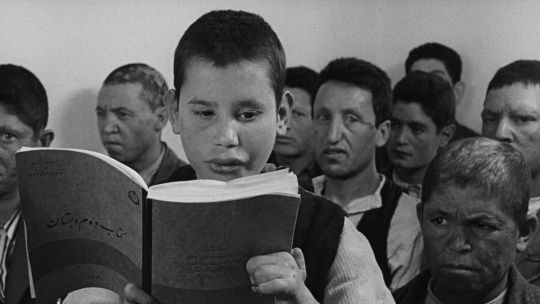
Sculpting in Time.
As the world inches into the future, we invited Justine Smith, author of the ‘100 Films to Watch to Expand your Horizons’ list, to look to the cinematic past to help us process the present.
It is said that the essential quality of cinema that distinguishes it from other arts is time. Music can be played at different tempos, and standing in a museum, we choose how many seconds or hours we stand before a great painting. A novel can be savored or sped through. Cinema, on the other hand, exists on a fixed timeline. While it can theoretically be experienced at double or half speeds, it is never intended to be seen as such. Cinema’s fundamental quality is experiencing time on someone else’s terms. As the great Andrei Tarkovsky said in describing his work as a filmmaker, he was “sculpting in time”.
The perception of time, however, is not universal. Our moods, our emotions, and our ideologies shape our relationship to it. Most Western audiences are further acclimated to Western cinema’s ebbs and flows, which similarly favor efficiency and invisibility. When we see a Hollywood film, we don’t want the story to stop. We want to be swept away and forget that we are all moving towards a mortal endpoint. Cinema, though, in its infinite possibilities, exists far beyond these parameters. It can challenge and enrich our vision of the world. If we open ourselves up, we can transfigure and transform our relationship to time itself.
When I first put together my 100 Films to Watch to Expand your Horizons list, I did it quite haphazardly. I imagined countries, filmmakers and experiences that I felt went under-appreciated in discussions of cinema’s potential. Intuitively, I went searching for corners of experience that expanded my own cinematic horizon. Some of these films are well-loved and seen by wide audiences; others are virtually unknown. It was often only after the fact that the myriad of intimate connections between the films came to light.

Manuel de Oliveira’s ‘Visit, or Memories and Confessions’ (2015).
“The only eternal moment is the present.” —Manoel de Oliveira
Released in 2015 but made in 1982, Visit, or Memories and Confessions is a reflection on life, cinema and oppression by Portuguese filmmaker Manoel de Oliveira. If we were to reflect on cinema’s history, few filmmakers have the breadth of experience and foresight as Oliveira. His first film was made in the silent era using a hand-cranked camera. By the time of his death at 106 years of age, he had made dozens of movies, including many in a digital format.
He made Visit, or Memories and Confessions in the shadow of the Portuguese dictatorship. While filming, he imagined he was in the twilight of his life. It revisited essential incidents in his history but also that of his country. It’s a film of reconciliation, violence and oppression, told tenderly in a home lost as a consequence of a vindictive dictatorship. Oliveira’s film, like his life, spanned time in a way that stretches perceptions. It’s a film without significant incident, about the peaceful pleasures and tragedies of daily life.

Elia Suleiman’s ‘The Time that Remains’ (2009).
What worlds have changed over the past one hundred years? The same breadth of perception, which often feels too seismic to tackle in traditional narrative cinema, was also explored in The Time that Remains. In a retelling of his family’s history, Palestinian filmmaker Elia Suleiman also tells Israel’s story. It is a film of wry comparisons and Keatonesque comic patterns. As borders change and time passes, few things fundamentally change, except on a spiritual plane. What happens to people without an identity or a country? What damage does it do to their souls?
The question of time looms heavily in both Oliveira’s and Suleiman’s films. They are movies that contemplate centuries of experiences and explore how those stories are guarded, twisted and erased by the powerful.
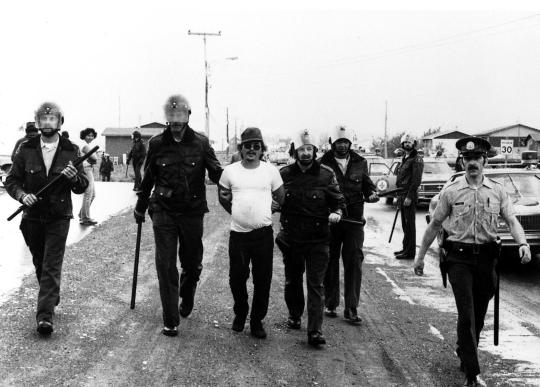
Alanis Obomsawin’s ‘Incident at Restigouche’ (1984).
The echoes of history and attempts to break with old patterns often emerge in other anti-colonial and anti-imperialist films. They can be seen in Alanis Obomsawin’s vital and angry Incident at Restigouche, about an explosive, centuries-in-the-making 1981 conflict between Quebec provincial police and the First Nations people of the Restigouche reserve; In Lagaan: Once Upon a Time in India, villagers must win a cricket match to free themselves from involuntary servitude; and in Daughters of the Dust, the languid pace of the Gullah culture is challenged by the promise and violence of the American mainland.
Time, more than just a tool for chronology, becomes in itself a tool for oppression. Those who control time maintain power. If we are to break with dominant histories, the rhythms of oppression must be broken and challenged.

Forugh Farrokhzad’s ‘The House is Black’ (1963).
“The universe is pregnant with inertia and has given birth to time.” —Forugh Farrokhzad, The House is Black
Persian filmmaker and poet Forugh Farrokhzad made just one film before her untimely death in a car accident when she was 32. The House is Black is a short documentary about a Leper colony, which utilizes essay-esque prose taken from the Quaran, and Farrokhzad’s poetry. It is a film about people who are seen as invisible by society at large, cast away and hidden. The film reflects on beauty, sickness and reconciliation. How does one experience time when you’ve been ostracized and cut off from the larger world?
Barbara Loden’s landmark independent film Wanda asks a similar question. A solo mother who cycles from one abusive situation to the next exists outside of time and space. She is invisible. If we look at most American cinema, it might as well be propelled by people who take control over their destiny, but what of the people who are (un)willingly passive to the whims of society and other human beings? In her powerlessness, Wanda stands in for the invisible labor and sacrifices of so many other women. The ordinariness of Wanda’s life, the dusty and dirty environments she inhabits, rebound with significance. It is, however, not a victorious film. Instead, it is a profound portrait of loss and beauty. It’s the only film Barbara Loden ever made.
"If you don't want anything you won't have anything, and if you don't have anything, you're as good as dead." —Norman Dennis in Wanda
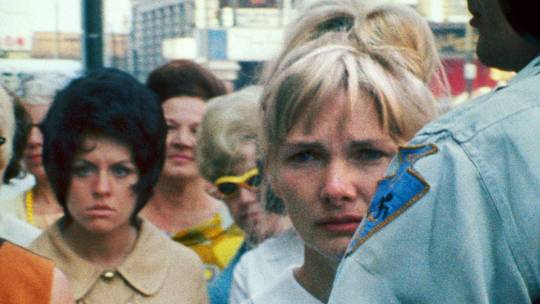
Barbara Loden’s ‘Wanda’ (1970).
In 2020, it seemed all we had was time. What seemed like an opportunity quickly became horrific. Time became a burden. We were reminded of our finite time on this Earth and all the hours spent commuting, working and surviving. The pandemic has had a seismic impact on our perceptions. In processing the ongoing crisis, we’ve transformed our relationship to the passage of time. We’ve altered the state of our reality.
This new pandemic gaze offers us new perspectives on time and history. The oldest film on the list is Erich Von Stroheim’s Blind Husbands, released in 1919 during the grips of the Spanish flu. The film does not reference the event, but its sensuality and class conflicts speak to a world on the brink of seismic change. It is a movie about an Austrian military officer who seduces a surgeon’s wife. The men grapple with jealousy and violence on a literal mountaintop, fighting for survival in an increasingly mechanized society.

Poster for Erich Von Stroheim’s ‘Blind Husbands’ (1919).
To this day, Blind Husbands is shocking. It’s profoundly fetishistic and loaded with heavy sexual imagery. It’s a movie about touch and desire absent of love and affection. It speaks to aspects of current life that feel lost and impenetrable. It speaks to growing and changing social disparities as well. Surviving the modern world is more than just surviving the plague; it has to do with value compromises and shifting power dynamics.
But, a pandemic is also about loss. Gregg Araki’s 1992 film The Living End explores the AIDS crisis from the inside out. Rebellious and angry, the film is about a gay hustler and a movie critic, both of whom have been diagnosed with the HIV virus. With characters who are cast out from society at large, gripped with a deadly and unknown fate, The Living End is apocalyptic—much like other Araki works from the 90s, such as The Doom Generation and Totally Fucked Up. It captures the deep sense of hopelessness of experiencing a pandemic while also belonging to a marginalized group. What is so radical about Araki’s cinema, though, is that it is also fun. It is a film that transcends mourning and becomes a lavish punk celebration. It is a film about survival, out of step with dominant ideology and histories.

Gregg Araki's ‘The Living End’ (1992).
The connections between Blind Husbands and The Living End bridge together to form common passions and changing perceptions. Both films are products of their time, at once part of distant histories but also uncomfortably prescient. More than films about a specific time and place, they are transformed by the time we live in now. To watch and connect with these movies in a pandemic means looking and living beyond the current moment.
While it seems like cinema might be facing an especially precarious future, it feels like the ideal art form to process what is happening right now. Caught in the vicious patterns of our own creation, giving ourselves up to the rhythms of someone else’s will might be a necessary form of healing, as well as an ongoing project in compassion. Time does not have to be a prison; it can be an agent for liberation.
Related content
100 Films to Watch to Expand Your Horizons
The Oxford History of World Cinema
1001 Movies You Must See Before You Die
The Great Unknown: High Rated Movies with Few Views
Follow Justine on Letterboxd
#justine smith#justine peres smith#world cinema#expand your horizons#gregg araki#manoel de oliveira#elia suleiman#julie dash#alanis obomsawin#Forugh Farrokhzad#barbara loden#erich von stroheim#mubi#criterion#criterion collection#letterboxd
15 notes
·
View notes
Text
Addiction as a Political Strategy
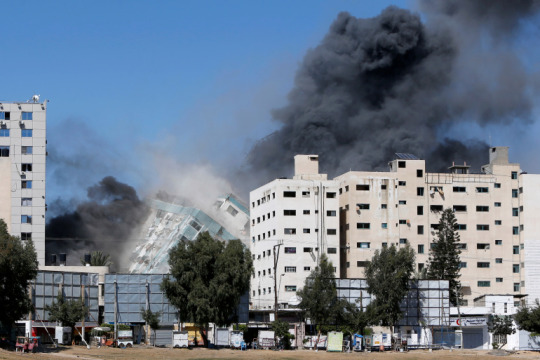
On Saturday, the Gaza headquarters of international media groups, including Al-Jazeera and the Associate Press, was felled by an Israeli air-strike.
According to the Independent, a spokesperson for the Israel Defence Force revealed that the building housed ‘Hamas military intelligence’, remarking that such a situation is common-practice for the organisation: ‘Hamas deliberately places military targets at the heart of densely-populated civilian areas in the Gaza Strip’.
Gaza’s contemporary population is estimated at just over two million. In terms of density, this estimate considers there to be, on average, around five thousand inhabitants per square kilometre. For comparison, according to the 2011 census, the population-density of the City of London is roughly equal. Can an area of this sort of density ever be a legitimate military target? Our nation’s capital remembers the Blitz with a shudder, still.
Indeed, there are serious questions to be asked. Asked of both sides, of course. For starters, if an offensively- and defensively-advanced nation-state is attacked by a far weaker neighbouring power, is it decent to expect some form of restraint from the former? Of course, it depends on the extent of the disparity between the two. But, given that there is such an inequality in terms of firepower, it is hard to discern what a proportionate response to certain attacks could be - one side simply cannot match the other, in any reasonable sense. Therefore, a focus on defence must be the answer. Perhaps, if paired with diplomacy, such a stance could contribute to meaningful, long-term de-escalation. But can a nation-state bare to suffer civilian casualties - or, even, fatalities - as a price? As has been evident from reporting on the latest conflagration, casualties in non-occupied regions of Palestine always outnumber the casualties in Israel. If you know that retaliation will endanger more of your opponent’s civilians as a rule, does it mean you must simply stomach the endangerment of your own civilian population? Nevertheless, that’s treating it like they are mere numbers, not human lives. On this asymmetry of death, however, must we simply reject claims that guerrillas use, to borrow a somewhat cynical phrase, ‘human shields’? Hiding amongst the crowds and the landscape is the recourse of the less armed. This does not, of course, justify the practice morally. But, again, given that you have considerable (but, necessarily, imperfect) defensive procedures, can your opponents’ guerrilla tactics justify your endangering civilians? Finally, is it proportionate to respond to evictions and police brutality with indiscriminate rocketing of civilian areas? In no uncertain terms, this is a terrorist tactic. But if you can expect nothing short of devastation, what do you have to lose? It may not be rational or moral, but it is understandable. It’s all understandable. Who of us would be rational?
In Britain, there is a species of common-sense which draws lines around areas of human activity deemed exempt from discussions of ethics and justice. Of course, in general, words like that tend to get laughed at or ignored - they smack of un-seriousness, a teenager’s petulance at reality. But of these international waters of morality, the war-zone is the most grey. Perhaps, this foggy British intuition grasps something: matters of war are also matters of the human condition, not only matters of geopolitics or morality. Despite the cynical manner in which it’s usually uttered, it allows us to raise questions about the nature of war which side-step the labyrinth of moral calculation as a facet of military strategy.
Last week, in the Israeli newspaper Haaretz, former Israeli politician Zehava Galon raised these questions and others, penning a column entitled: ‘Human Beings Are Able to Talk, Not Only to Carry a Club’. Her writing is fiery, polemical, but one turn-of-phrase in particular is fascinating: ‘addiction to the club’.
In Israel, all Jewish citizens over the age of 18 are required by law to undertake at least two years of service in the Israel Defence Forces. Usually, states introduce conscription in times of war. For around a decade, the IDF has adopted a set of strategies with regard to the Gaza Strip that are colloquially referred to as ‘mowing the grass’. In short, it is a strategy of long-term deterrence, periodically weakening militias in the area in order to produce periods of respite. The Begin-Sadat Center for Strategic Studies, which researches ‘Middle Eastern and global strategic affairs, particularly as they relate to the national security and foreign policy of Israel’, produced a study of the strategy, concluding that ‘Israel finds itself in a protracted intractable conflict’ requiring ‘a strategy of attrition designed primarily to degrade the enemy capabilities.’ The Center chalks this up to the nature of the conflict - it being against ‘hostile non-state groups’ - but, as Galon alleges, there may be an additional reason.
Personally and nationally, national service can take on a definitional function. To be blunt, if you have an enemy, you have an identity, a role, a community to which you belong. Perhaps, such negative-identifcations are an inevitable by-product of nation-building. But a video has been doing the rounds on Twitter which compiles a series of vox pops in Jerusalem that portray a violent scorn - ‘I would carpet-bomb them .. It’s the only way you could deal with it’ - for those in Gaza/Arabs/Palestinians - a sort of composite figure of the objects of the IDF’s strategies. One interviewee suggests that ‘Jews should have rights to hate them’. The interviewees justify these attitudes via the facts of the historic embattlement of the Jewish people, casting the state of Israel itself as representative of ‘divine justice’ or an incarnation of some redemptive new direction of history. Another video supposedly recorded by IDF soldiers has been shared widely. From the translated chatter, the video itself appears to have been recorded as part of attempts to capture exciting killings. This particular killing, seemingly of an unarmed young person milling around with another, is terrifically exciting to the group, the cameraman’s voice resounds with sheer glee at having caught it: ‘What a legendary video … He flew into the air and his leg was like…’
The Covenant of the Islamic Resistance Movement, the founding charter of the organisation now known by a colloquialism, Hamas, abounds with poetic images of war. Article 33 reads:
Ranks will close, fighters joining other fighters, and masses everywhere in the Islamic world will come forward in response to the call of duty, loudly proclaiming: ‘Hail to Jihad!’. This cry will reach the heavens and will go on being resounded until liberation is achieved, the invaders vanquished and Allah's victory comes about.
In the ruins of the Gaza Strip, some may have sought to make a pact with their fear and despair, to discover in it the howlings of history. Let it point the way. The recklessness of the militias’ attacks on Israel resonate with this particular desperation - and the scorn for human life that is its price. In the Covenant, ethnic hatred is expressed openly and in unashamedly violent terms. Article 7 reads:
The Day of Judgment will not come about until Moslems fight Jews and kill them.
In the Covenant’s view, the Jewish people represent a grand historic force which all Muslims must devote themselves to curbing. Article 22:
The enemies have been scheming for a long time […] They stood behind the French Revolution, the Communist Revolution and most of the revolutions we hear about […] They stood behind World War I […] and formed the League of Nations through which they could rule the world. They were behind World War II, through which they made huge financial gains […] There is no war going on anywhere without them having their finger in it.
Organisations like the IDF and Hamas blend claims to land with existential certainties, rationalising violent desires. Like a junkie rhapsodising about his creative break-throughs, these are political and historical arguments which obscure an addiction. A newsletter from the National Institutes of Health, a branch of the U.S. Department for Health and Human Services, notes that at a certain stage of addiction, ‘people often use drugs or alcohol to keep from feeling bad rather than for their pleasurable effects.’ All addicts are, to use a pop-psych phrase, running from something. Under the influence of addiction, one’s despair and fear become engines of joy, pressing you onwards towards release. Therefore, like some anti-Addicts-Anonymous, organisations like the IDF and Hamas provide infrastructures of protection and facilitation for war-addicts.
And that is the kicker: none of this constitutes some personal particular fault with Jewish Israeli citizens or Arabic Palestinian Muslims. Nationalist political organisations are cynically perpetuating themselves through these methods. Indeed, they are the agents of these conflicts, ordinary people are merely their addict-conscripts. Your dealer is not your friend.
Therefore, we raise issues of justice in matters of war to avoid these all-too-human eventualities. Raising those issues retains our focus on the central questions of the validity of a violent action, of vested interests and consequences. What is needed - in any war, anywhere - is an orientation towards the discourse of war which accepts that it is always susceptible to the distortions of the addicted mind. Forever, the question is: should this war-zone exist at all?
Galon and Tair Kaminer - a 24-year-old Jewish Israeli citizen who, having served a short sentence for refusing national service, was arrested in Jerusalem over the weekend for organising a solidarity protest of Jews and Arabs - and the legendary Hanan Ashrawi are pointed examples of a banality which is nevertheless worth re-emphasing: no nation falls totally under the spell of this addiction. The collective delirium of war never swallows populations nor individual minds whole. Always, always there are other ways. For instance, questions of rights to land are the (literal) solid ground to which we can return. Bring them into focus.
Footage from the Snapchat of an attendee at a Free Palestine protest in Nottingham City shows a car aggressively parting a line of protestors. The perpetrator has not yet been identified.
1 note
·
View note
Text
The Price of American Exceptionalism

The New York Times reported on July 9th that the newly installed head of Voice of America, a critical soft power organ for US foreign policy for nearly 80 years, was strongly considering not extending visas for foreign journalists working at the agency. This decision followed on the heels of ICE’s announcement that foreign students not able to take in-person courses for the upcoming Fall semester would be forced to leave the country.
These decisions taken by themselves are certainly bad, but it is their place in the broader context of four years of self-defeating American policies that make them especially hard to swallow. At a time when the world desperately needs unity and answers, when democracy and freedom are on the backslide around the world, the United States continues to embrace a specious concept of American exceptionalism. It is an impoverished one that confuses weakness and fear for strength. And one that ultimately will do more harm to the country’s standing in the world at a time when it is most needed.
From its earliest days, this administration has repeatedly turned its back on immigrants and traditional allies. Our collective ability to stay focused on one issue has been disoriented by the endless stream of shit that the White House and propaganda machine spews into the ecosystem, but these are just a few that come to mind.
A travel ban from majority-Muslim nations in the first week of the administration; constant undermining of longstanding alliances and partnerships, including those with NATO, South Korea, Japan, and the Kurds; repeatedly cozying up to despotic regimes who actively or have in the past harmed America’s national interest, including Russia, Turkey, China, and North Korea; a family separation policy that caged children and kept them apart from their parents, in the name of ‘deterrence’; scaling down the refugee cap more and more each year, bringing it to its lowest point in several decades; and a temporary suspension of the H1-B visa program.
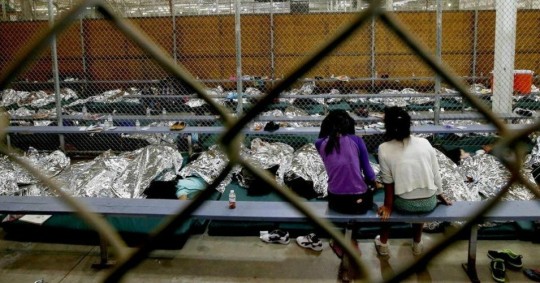
(A Detention Center at the Southern Border, Key for ‘Deterrence’)
There are probably too many to recount here, too many for me to even recall. But time and again the one defining through line of the Trump Administration has been a rejection of American values and an embrace of things inimical to the American tradition. This has been said many times during this administration and to those steeped in the minutiae of day-to-day policy shifts, it is all too obvious and probably even cliché. But most Americans are not those people, nor are global citizens who look to the United States for guidance. And we shouldn’t lose sight of the incredible damage these four years of Trump governance have done to this country and its place in the world. We are less trusted by allies, less feared by our enemies, and less able to make meaningful change in the world. We cannot accept this new normal; we cannot grow numb.
I am not naïve. I know the United States has not lived up to its ideals in the past, I know that it probably hasn’t even lived up to its ideals for the majority of its existence. But it – and the leaders its people have chosen through the years – at least pretended to care. We have reached the point now, however, where the people in charge do not even pretend.
Unsurprisingly, the administration’s willful negligence has affected the way Americans and the world view the country. A recent Gallup poll conducted in June, for example, found that American pride has fallen to a nearly two decade low, among both Republicans and Democrats. For all the rhetoric about restoring American greatness, it is clear that these past few years of scorched earth governing that tears down rather than builds up has exhausted the American public. Beyond that, though, the rejection of patently American ideals like diversity and inclusion, this time in both word and deed, has likely soured the public on its government and country.
After all, it’s hard to be proud of a country in which the president praises Neo-Nazis, in which George Floyd and so many other Black Americans can be indiscriminately harassed and murdered by police, and in which inequality has become an even more important fact of life.
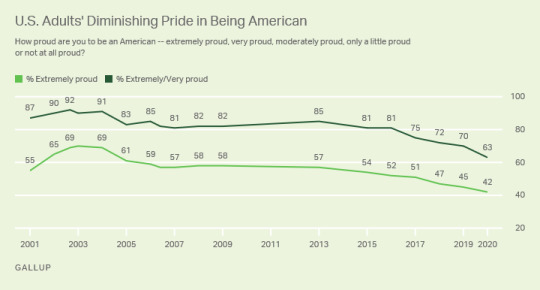
This dynamic can also be seen on the world stage, where trust and respect for the United States have fallen under the current president. Pew conducted a poll in January of this year and found that while confidence in the US has dipped somewhat, faith in its leader is dramatically lower, a product of both the president’s rhetoric and policies as well as democratic erosion here at home.
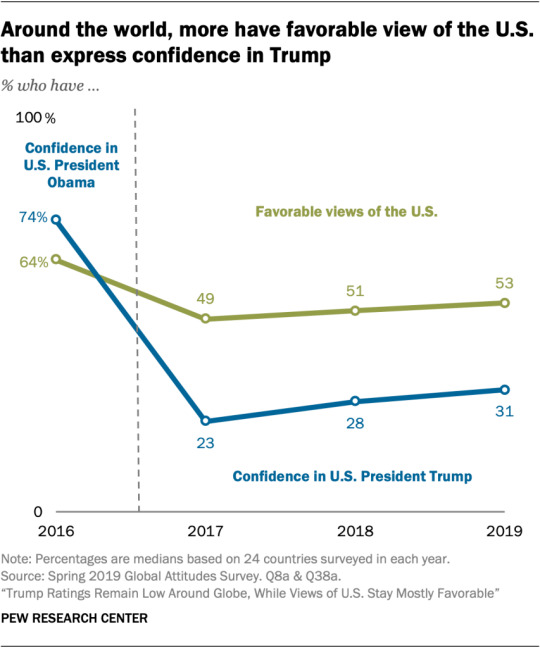
These drops are most pronounced among some of the country’s traditional allies, especially European allies, according to the same poll.
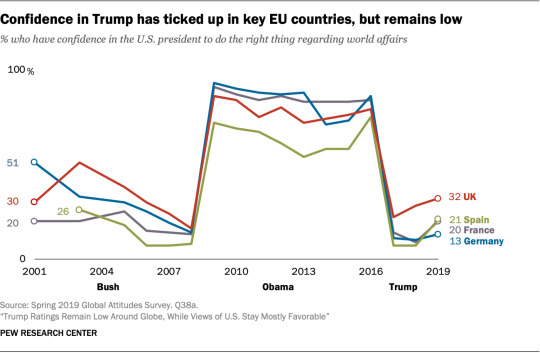
Notably, the current president enjoys similar levels of international support to another Republican president this century who used the power of his office to bully allies abroad and citizens at home into adopting a worldview hostile to their own values in the service of American “exceptionalism.” But who has the time for such pettiness?
Leaving aside such comparisons, what is clear is that the United States, the supposed leader of the free world and a global beacon for freedom, has seen itself steadily lose its claim to that mantle over the last four years. And I can hardly imagine a worse time for our credibility as a purveyor of democracy and freedom, however imperfectly we live up to those ideals, than now. Freedom is under assault everywhere.
In Europe, far-right parties continue to make inroads in countries, some we classify as fledgling democracies and others who are democracies. Far right leaders and parties in Hungary and Poland, for example, continue to threaten their status as democracies and wage rhetorical war on minorities like Muslim refugees and Jews, while the AfD in Germany grows more powerful by the year. Part and parcel of this trend, opposition to migration continues to gain strength throughout Europe and empowers these right-wing parties. The US government, needless to say, does little to oppose these trends. Its rhetoric alone I would argue gives tacit support to movements like these that seek to fall back on the crutch of religious or ethnic nationalism. Additionally, it hardly needs mentioning here what the United States’ current policy towards Russia, the greatest threat to democracy in Europe today, is under this administration.
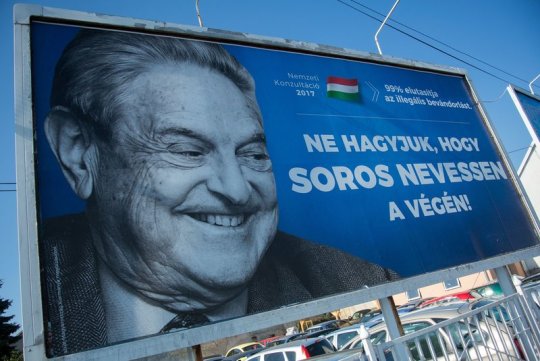
(George Soros, a Popular Target of Anti-Semitic Smears in Hungary)
In the Middle East, a region in which we have waged war for decades and spent trillions of dollars in the name of freedom, we continue to bankroll oil rich Gulf nations who have repeatedly harmed American interests and American citizens, whether through funding extremist activities, waging merciless war against a Yemeni population unable to defend or feed itself, or hampering our foreign policy objectives in the region. Rather than push back against these nations and use the leverage it has, the administration (admittedly, like those before it) allows Saudi Arabia and its partners to dictate the terms of our relationship.
This is to say nothing of Israel, a country with whom we have always had close ties and nevertheless have pushed to make itself a better, more democratic place. Republican and Democratic administrations alike, to varying degrees, have held that a two-state solution is the only way to ensure Israel’s continued existence as both a democratic and Jewish state. More importantly, they have agreed it was the only way to recognize the agency and humanity of the Palestinian population, who exist primarily as second-class citizens. The Trump Administration by contrast gave explicit sanction of the Israeli occupation by agreeing to move its embassy to Jerusalem, a slap in the face to 5 million Palestinians. Rather than be punished for annexation and settlement building, however, the current right-wing Israeli regime was rewarded by the supposed leader of the free world with a gift it has coveted for decades, explicit recognition of its occupation, its settlements, and control over what some consider a semi-apartheid state.
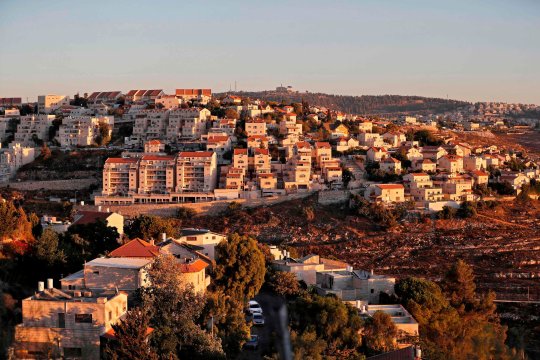
(Israeli Settlements in the West Bank, Illegal but American-Sanctioned)
And in Asia, despite hard-edged rhetoric purporting to represent strength, the US has ceded ground to its number one geopolitical foe and given tacit recognition to North Korea’s nuclear program. Bending over backwards to secure a trade deal he believed would help his reelection efforts, the president has turned a blind eye as China becomes one of the greatest threats to democracy and free expression anywhere in the world.
Getting tough on China apparently looks like giving explicit support to China’s program of “reeducation” of its Uyghur population, or as I call it sending ethnic minorities to work camps in order to practice eugenics upon women and indoctrinate children while depriving them of food and freedom. Getting tough on China also looks like allowing it to eliminate any semblance of freedom in Hong Kong, a global hub of commerce and free expression, with scant repudiation of a dead-of-night passing of a law that punishes any Hong Kong citizen or international traveler who speaks ill of China with threat of imprisonment. Getting tough on China also looks like allowing it to bully and harass its neighbors in the South China Sea with armed piracy and threats of economic or military retaliation, or infringe upon Indian sovereignty with threats of armed conflict.

(An Uyghur Re-Education Camp in Xinjiang, China -- in the 21st Century)
With North Korea the president gave in, as he always does, to flattery and cajoling and turned his back on the longstanding American position regarding North Korea’s nuclear arsenal. In a flashy summit with Kim Jong Un, the president committed the United States to formally ending the Korean War and issued weak demands that North Korea suspend its nuclear program, all while kissing the ass of a man who starves and murders his people and gaining little in return. Today, North Korea possesses a nuclear arsenal capable of striking the United States, has shown it has little appetite for joining the fold of developing nations, and was granted legitimacy by the most powerful person on Earth for what amounts to basically nothing. The summit gained the US and our allies in the Asia Pacific precious little while giving North Korea nearly everything it desired. Another diplomatic coup for our president. Thank you, sir.
A well-functioning administration would perhaps realize that they have been gifted a world in which a rhetorical and foreign policy approach that prioritizes freedom and democracy would allow it to press the advantage against the bevy of undemocratic regimes it considers its enemies. An appeal to Hong Kong that attempts to market it as a Berlin Wall, a symbol of oppression and freedom denied, could help turn the pressure up on China. So too would a forceful denunciation of fucking ethnic minority labor camps.
Or perhaps a policy that tries to use its authority over the Gulf nations to force positive change. Or maybe a commitment to European democracy and the values of free expression and inclusion. Or an attempt to leverage our strong military and diplomatic relationship with Israel to force it to make difficult concessions on the Palestinian cause, rather than roll over for a regime that has proven itself stubbornly unwilling to compromise despite our generosity.
Even in our own backyard there are things we could be doing to enhance the cause of freedom and inclusion. We could tell refugees fleeing oppression that they can come to the United States. We can peel away the best and brightest from other countries around the world so that the brilliant scientist from Iran or the entrepreneur from China is a student that we deprive those hostile regimes of profiting from. We could tell immigrants, some undocumented, who are here laboring on the frontlines against a once-in-a-lifetime human catastrophe that they deserve to be fast tracked for citizenship or legal status.
We could do so much that would help this country’s cause in a time of ceaseless threats to democracy. But we don’t. The rot at the heart of our government that makes Americans bristle with shame at their country, that makes the world look askance at us as it does our enemies, prevents us from doing any of this. Our leaders have forgotten the values we are supposed to uphold and represent. In the process we have grown far weaker while our foes and enemies of human rights and freedom around the world have grown far stronger.
Freedom is no longer something those in power, and even some Americans, understand. That loss of understanding has eroded our confidence in ourselves and has eroded the faith the world places in us. Freedom has become, to quote Jimmy Carter, “a proverb in a dusty book that we read just on the Fourth of July.” A thing we claim to have but don’t truly understand anymore. This cannot be blamed all on the current administration, but its acceleration can be. And the losers from this immoral four years of American failure are not just Americans and our future dreams; they are the freedom seekers around the world who need a beacon more than ever. They are the ones who may pay more than anybody. That will be the price of four years of hate and division, of nativism and immorality.
That will be the price of Trump’s American Exceptionalism.

1 note
·
View note
Link
“There’s no place for illusions that this combination [of tactics] could turn the Arabs into loyal citizens, but over time it will reduce to some extent the open hostility and prevent its active expression.” – From a document containing recommendations for dealing with the Arab minority in Israel, September 1959, Labor Party Archives
As early as 60 years ago, Israel’s political leadership gave up on the attempt to integrate the country’s Arabs and grant them equal citizenship. A document drawn up for an internal discussion in Mapai, the ruling party and forerunner of Labor, in September 1959, proposed the implementation of policy based on the following approach: “We should continue to exhaust all the possibilities [inherent in] the policy of communal divisiveness that bore fruit in the past and has succeeded in creating a barrier – even if at times artificial – between certain segments of the Arab population.”
The assessment that the Arab public would never be loyal to the Jewish state remained entrenched in the following decade as well. For example, it underlay a lengthy document written by Shmuel Toledano, the Prime Minister’s Advisor on Arab affairs. In July 1965, the document served as the point of departure for a top-secret discussion between Toledano and the heads of the Shin Bet security service, the Mossad, the Israel Police, the Foreign Ministry and the Education Ministry (representatives of the Arab public weren’t invited).
According to the document, “We must not demand from the Arab minority loyalty in the full sense of the word, to the point of identifying with the goals of a Jewish state (ingathering of the exiles and other values related to the national and religious way of life of the Jewish people). Such a demand is neither practical nor legitimate.” Instead, “We should strive for the Arabs’ passive acceptance of the state’s existence and for them to become law-abiding citizens.”
These two documents address diverse issues having to do with the life of Israel’s Arab citizens. They help illuminate the state leadership’s official efforts to prevent the politicization of Arab society as well as its resistance to the emergence of a modern leadership among the country’s Arabs. These discussions were held, it bears noting, at a time when the majority of the Arab community in Israel (the exception being residents of Haifa and Jaffa) lived under a military regime – which was not lifted until 1966 – that included a permanent night curfew and a need for permits for traveling in the country.
One item on the agenda of the 1965 discussion was the “Arab intelligentsia” in Israel. The document drawn up in that connection stated emphatically, “The formation of a broad educated class must be averted as far as possible.” Reason: An educated class tends to adopt “positions of radical leadership.” Accordingly, the document recommended “gradual solutions.” For example, “The entry of Arab students into institutions of higher learning should not be encouraged, but into professions and industries that hold the promise of appropriate employment.” The document elaborates: natural sciences and medicine – yes; humanities and law – no.
The core of the Toledano document is its recommendation to block creation of political associations among the Arabs “in order to prevent the establishment of separate political entities on a national basis.” From the state’s point of view, the Arab electorate should manifest itself in the form of support for the Zionist parties. The latter, for their part, should open “their gates” to the Arabs and integrate them into their ranks “gradually and experimentally.”
The grounds for this approach can be found in the 1959 document. It states that the policy of divisiveness pursued so far regarding the Arab population “has allowed the state, during the period of its existence, to prevent the consolidation of the Arab minority into a united bloc, and in large measure has given the leaders of each community an outlet to deal with their communal affairs instead of with general Arab affairs.”
A perusal of the documents generates a feeling of sad irony. In the 1950s and ‘60s, the Israeli leadership acted vigorously to prevent the establishment of independent Arab political parties. The aim was to have slates of Arab candidates appended to the Zionist slates via “satellite parties,” and for Arab representatives to be guaranteed places in the parent parties. In other words, independent Arab parties conflicted with the establishment’s interests.
Today, in contrast to the establishment’s position at the time, the Arab parties are independent entities, while the Zionist parties have hardly any Arab representatives. But this is an illusory reversal: Substantively, little has changed. Whereas the goal of integrating Arabs into the Zionist parties in the country’s first decades was intended to depoliticize the Arab community, their displacement from the big parties today only preserves the separation between the peoples and distances the Arab community from the centers of decision-making. If at the outset the Arabs were a fig leaf, today they have become a scapegoat.
In opposition 70 years
Even today, separation remains the underlying rationale of the near-absence of Arab MKs in the center-left parties. Not only does the current situation reflect the will of the parties’ leaders (which include parties that don’t even have a primary), at times they seem to be competing among themselves over who is most hostile to “the Arabs.” The Labor Party, for example, has shown in recent years that it has no interest in true activity by Arabs within it, and its slate of Knesset candidates doesn’t guarantee a realistic slot for an Arab representative. Similarly, among the first 40 places on the Kahol Lavan ticket, there is only one Druze woman, in 25th place.
The Mapai document states that “stable rule in the country is inconceivable with most of the Arab minority in the opposition.” That evaluation has been refuted. The Arab public has been in the opposition for 70 years, lacking any real strength, even though this is not what most Arab citizens want. A survey commissioned by Haaretz before the 2015 election campaign found that 60 percent of the Arab community would like to join the government, and only half the respondents made this conditional on its being a left-wing government.
The Arabs would like to play a concrete role in the decision- and policy-making processes. Electorally, this poses a threat to Prime Minister Benjamin Netanyahu’s rule. At the same time, it’s clear that his opponents are toeing the same line, explaining to the public that “the Arabs” are beyond the pale, and even factoring them into an equation of “neither Kahane nor Balad” – referring an unwillingness to contemplate either a coalition or even a blocking majorith with either the far-right Otzmat Yisrael party or the nationalist Arab party Balad.
In this sense, keeping the peoples apart no longer necessitates segregation that’s maintained by ordinances and regulations. The military government may have been abolished, but its spirit still rules, on the right, in the center, on the left – everywhere.
15 notes
·
View notes
Photo

JACOBIN MAGAZINE
For the past few years, a group of nine Israelis led by human rights lawyer Eitay Mack has sought to peel back the layer of secrecy shrouding Israel’s collusion with some of the worst genocide regimes in the world. They have done so by filing freedom of information requests with their country’s defense ministry, seeking documents concerning Israeli arms deals, consulting contracts, and training of the armed forces in Sri Lanka, Myanmar, Serbia, South Sudan, and Rwanda during decades of ethnic conflict in those nations. They’ve sought to learn the extent of the trade, what weapons were supplied and to whom, how the weapons were used, and how long the trade continued.
In every instance, the ministry denied their request, and they were forced to appeal to the Supreme Court. In every appeal, the court has sided with the military and ruled that such information was legitimately sealed from public view in order to protect the security of the nation.
It’s difficult to understand how the knowledge that Israel armed Rwandan murderers in the 1990s would harm national security. Much more likely, this exposure would damage Israel’s reputation and give ammunition to critics who claim it is a rogue state intent on violating international law and norms of conduct.
Protecting the State
In Israel, a national security state in which individual rights and the public’s right to know are subordinated to the interests of the military-intelligence apparatus, these two factors are often conflated. It is much easier to justify secrecy using the concept of protecting the state and its citizens than it is to admit that secrecy is meant to protect the reputation of the very security apparatus charged with protecting them.
Israel has recently censored two major reports claiming that the country was secretly arming nations and groups engaged in genocide or mass violence. The first again concerned Eitay Mack, who had appealed to the Supreme Court to permit exposure of Israeli arms trade to Sri Lanka’s Sinhalese forces. These forces exterminated the Tamil Tiger rebellion during a thirty-year civil war that ended in 2009, with the loss of forty thousand to seventy-five thousand civilians and combatants.
Here is Mack’s account of the major role Israeli weapons played in some of the worst massacres of that thirty-year civil war:
In Sri Lanka the State of Israel played a most pivotal role in war crimes and crimes against humanity carried out there: [it] supplied drones which directed planes and warships made in Israel, and these deliberately targeted and bombed civilians and . . . humanitarian sites, and determined the fate of the war at an extremely high human cost. Sri Lankan forces which carried out the crimes had received [Israel Defense Forces] IDF training (especially from the Israeli Air Force and Navy), as well as from the Israeli Police.
One of the famous cases in which Israeli Kfir planes were used took place on August 14, 2006. The Sri Lankan air force used Kfir planes to bomb an orphanage for girls, in which 400 girls . . . resided. Security forces claimed the girls were being trained to be LTTE [Tamil Tiger] combatants. Around 60 girls were killed on the spot, and tens of girls were injured. Earlier, in 1999, another Israeli war plane attacked a school, killing 21 children and teachers.
The Government of Sri Lanka and [its] senior officials . . . have repeatedly [revealed], in official as well as media interviews, during and after the war, details [of] Israeli security exports, their extent and their massive use in the effort to win the war. Repeated statements [acknowledging] watching Israeli drone footage ahead of every attack, have incriminated the Sri Lankan government and proven that civilians and civilian targets had been deliberately hit with full awareness of the government’s security forces.
District Court Judge Shaul Shohat ruled that documents held by the Israeli defense ministry could be protected from public view. But his argument revealed the inner workings of the security apparatus and how it works hand in glove with the judiciary and intelligence services. He revealed that he held closed-door hearing with the state’s representatives, including attorneys, defense ministry officials, and even Israel’s national intelligence agency, the Mossad, from which Mack was excluded.
During this hearing, the state presented secret evidence to the judge meant to persuade him that revealing any of this information would irreparably harm the state. Shohat dutifully agreed with the defense and wrote in this passage of his ruling (one of the passages the defense ministry sought to suppress is in italics):
I . . . learned from a review of these documents that most of the[m] deal with the operational capabilities of the IDF and the security industries involved in various deals, and their ties with military industries in Sri Lanka. The documents contain the details of internal discussions among senior officials in the security establishment regarding the issue as well as discussions and agreements between senior officials in the security establishment and senior officials in the Sri Lankan government, specifically involving the formulation of security policies; working procedures and internal processes in the Ministry of Defense, mutual visits and data as to the deals that were signed and the extent of military exports, including the specification of various types of weapons, etc. It was also noted that there is a secrecy agreement with Sri Lanka, and that its violation by Israel would create a problematic precedent which would reflect on relations with other states, harm existent secret agreements and deter other states from forging new military ties [with Israel]. It was argued in this context that even if Sri Lanka has violated its obligation by the agreement and published specific, ad-hoc information, this does not detract from the State of Israel’s obligation under the agreement.
Israeli journalist John Brown published a report in Haaretz on Shohat’s ruling. Shortly thereafter, he discovered that the defense ministry division responsible for protecting military secrets, MALMAB, had asked the judge to censor a portion of his ruling, which Brown had included in his article. The ministry’s main concern was preventing the revelation of the fact that representatives of the Mossad had urged the judge to restrict media publication about Israeli arms sales to Sri Lanka. MALMAB also sought to suppress media reporting about the secret nature of the weapons dealing. Both parties had agreed to maintain secrecy about them (even though Sri Lankan officials had since revealed them publicly).
Brown appealed via Facebook for others to protect and preserve the article in the event it was censored. It seems that even censors in a national security state face obstacles, as the article remains available, uncensored, on the Haaretzwebsite.
Another reason why the Israeli censor may be extremely sensitive to revealing such information is that the International Criminal Court (ICC) has announced pre-trial proceedings investigating Israel’s conduct during the 2014 Gaza invasion, Operation Protective Edge. During the month-long conflict, 2,300 Palestinians were killed, two-thirds of whom have been declared civilians by independent Palestinian human right groups and the United Nations.
The ICC announced the pre-trial phase amid this year’s Great March of Return, during which Israel has murdered nearly two hundred Gazans protesting Israel’s siege of the enclave. Israeli officials are aware that the publication of any evidence that it has been an accessory to genocide in other conflicts could bolster a case to be made before the international court.
Returning to Sri Lanka, it’s no wonder, given the close relations between Israel’s military and Sri Lanka’s, that the army chief of staff responsible for the genocide, after the conclusion of his Sri Lankan military service, was appointed the nation’s ambassador to Israel.
(Continue Reading)
34 notes
·
View notes
Text
Hatred, Fear, Hope
Like most Jewish Americans, I was caught off-guard back in 2017 by the sight of white supremacists marching in Charlottesville, Virginia, and carrying aloft the flags of the Confederate States of America and Nazi Germany. (That they were also carrying the so-called Gadsden Flag that was originally used by the Continental Marines during the American Revolution—the one designed back in 1775 by Christopher Gadsden featuring the words “Don’t Tread on Me” beneath a coiled-up, scary-looking rattlesnake—struck me primarily as a sign of how little these people know about the values upon which the nation was founded in the first place.) The sight of those flags being held aloft proudly and defiantly was beyond upsetting, but not particularly confusing. But what was confusing—to me and I suspect to most—was the chant “Jews will not replace us,” which I hadn’t ever heard before and which I now realize I misunderstood, taking it to mean something entirely different than what it apparently does mean.
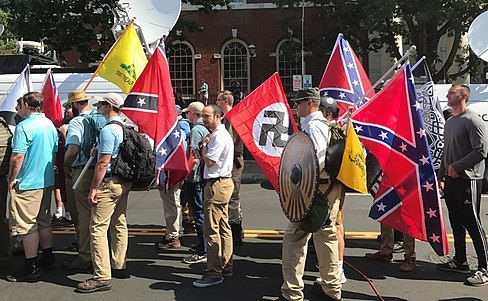
Taking the slogan at what I thought was face value, I understood the marchers to be declaring their determination not to allow themselves to be replaced by Jews eager to take over their jobs and leave them without work and eventually destitute. In other words, I imagined this somehow to be tied to the marchers’ skittishness about the job market and their need to find someone to blame in advance for losing jobs they fear they only haven’t lost yet and in which they fear they will eventually, to use their own word, be “replaced.” It hardly seems like a rational fear, but that’s what it felt like it had to mean, and so I ended up taking it as just so much craziness rooted not in anything corresponding to actual reality but in the malign fantasy that, left unchecked, we Jewish people will somehow take over the world and install our own people in whatever jobs we wish without regard to where such a move would leave the people currently holding them. And that is what I sense most Jewish people—and maybe even most Americans—hearing this chant took it to mean.
But now that I’ve read more, I see that that is specifically not what “Jews will not replace us” means and that the slogan specifically is not about Jews replacing Christians at work at all. Instead, the chant encapsulates the marchers’ fear that we Jews are working not to take over their jobs ourselves but to replace them at work with third-party others chosen specifically to deprive them of their livelihoods and their places in society. And who might these other people be? That, it turns out, is where anti-Semitism and racism meet: the hordes of jobseekers the marchers fear turn out not to be Jews at all, but hordes of dark-skinned immigrants feared already to be pouring over our borders and insinuating themselves into an already-tight job market. And it is those people who, because they are presumed ready to work at even the most menial jobs for mere pennies, are imagined to be threatening the white (i.e., non-immigrant) people who currently hold those jobs and who earn the American-sized salaries they use to support themselves and their families.
To say this is crazy stuff is really to say nothing at all. Yes, we have a huge and so-far-unresolved issue in this country with illegal aliens living in our midst and I’m sure that those people do take jobs that legal residents might otherwise have. And lots of non-crazy people, myself definitely included, are eager to find a way out of this morass that we ourselves have created by failing to police our borders adequately and by allowing the number of undocumented illegals in our midst to grow from a mere 760,000 or so in 1975 to something like 12.5 million today with no obvious solution in sight.
So wanting a reasonable solution to be found—one that is fully grounded both in settled U.S. law and in our national inclination to be just, fair, kind, and generous, and one that doesn’t make after-the-fact chumps out of all those countless millions of people who followed all the rules and immigrated here fully legally—is not crazy at all. What is crazy is the fantasy that Jewish Americans somehow possess the secret power to order Walmart’s and Costco and every other American business to fire specific employees and replace them with pre-selected others regardless of whether those others are or are not here legally. Crazier still is the contention that American Jews somehow control American immigration policy, and that we are somehow able imperiously to issue instructions that must be obeyed both to Democratic and Republican administrations. But craziest of all is the belief that, precisely because American Jews are so supremely powerful, we must be attacked violently before we order the administration to let even more immigrants into our nation. That, after all, was the specific reason the Pittsburgh shooter gave for his savagery in a comment posted online just before the attack: to give the officers of HIAS pause for thought before they work to bring in any more “invaders [to] kill our people.” My post-Pittsburgh proposal is that we stop dismissing that line of thinking as aberrant looniness that no normal person could actually embrace and start taking it far more seriously.
It feels natural to consider the various kinds of prejudice that characterize our society as variations on a common theme. And in a certain sense, I suppose, that is true. But these pernicious attitudes are also distinct and different, both in terms of their root causes and the specific way they manifest themselves in the world: misogyny, racism, and homophobia, for example, are similar in certain cosmetic ways, but differ dramatically in terms of the specific malign fantasies that inspire them and thus should (and even probably must) be addressed in different ways as well. And we should also bring that line of thinking to bear in considering anti-Jewish prejudice: similar in some ways to other forms of prejudice, anti-Semitism also has unique aspects that it specifically does not share with other forms of bigotry. Indeed, the fact that the anti-Semitism put on public display in Charlottesville was rooted in the haters’ groundless yet powerful fantasy about the almost limitless power imagined somehow to have wound up in the hands of the hated is all by itself enough to distinguish anti-Semitism from other kinds of prejudice. And not at all irrelevant is that it appears not to matter at all how impossible it feels to square that fantasy about Jewish powerfulness with the degree to which powerless Jews have suffered at the hands of their foes over the centuries, and particularly in the last one. In that regard, I would like to recommend a very interesting essay by Scott A. Shay, the author and Jewish activist, that was published in the Pittsburgh Post-Gazette a few days after the shooting at Tree of Life Synagogue and which readers viewing this electronically can access by clicking here.
Nor is this a problem solely of one extreme end of the political spectrum. In the wake of Pittsburgh, the spotlight is on the anti-Semitism that characterizes the extreme right, but the same light could be shone just as brightly on the anti-Semitism of the extreme left…and particularly when it promotes hostility toward Israel’s very right to exist and to defend itself against its enemies. Indeed, the assumption that Israel—instead of being perceived as an outpost of democracy smaller than New Jersey trying to survive in a region in which it must deal with nations and political terror groups that openly express their hope to see Israel and its Jewish population annihilated—is perceived as an all-powerful Goliath seeking to eradicate its innocent opponents militarily rather than to negotiate fairly or justly with them, is part and parcel of this fantasy regarding the power of the Jewish people. Coming the week after Hamas fired over five hundred missiles at civilian targets in Israel, each capable of killing countless civilian souls on the ground, the image of Israel as the aggressor in its ongoing conflict with Hamas sounds laughable and naïve. But maybe we should stop laughing long enough to ask ourselves how this myth of Jewish power—whether focused on American Jews imagined to be in control of American foreign policy or Israeli Jews imagined to be intent on crushing their innocent victims for no rational reason at all—perhaps we should ask ourselves how we might address, not this or that symptom of the disease, but the disease itself.
Distinct (at least in my mind) from theological anti-Semitism rooted in the supersessionist worldview promoted for so long by so many different Christian denominations, this specific variety of anti-Semitism seems rooted not in messianic fervor but in fear. And that, I think, is probably how to go about addressing it the most effectively: by pulling that fear out into the light and exposing it as a fantasy no less malign than inane. By forcing young people drawn to the alt-right to look at pictures of the innocents murdered in Pittsburgh and to ask themselves if they truly have it in them to believe that U.S. government policy was until two weeks ago being dictated by 97-year-old Rose Mallinger or by Cecil or David Rosenthal, both gentle, disabled types whose lives were built around service to their house of worship. By forcing young people poisoned with irrational hatred of Israel to look at the portraits of the 1,343 civilians murdered by Palestinian terrorists since 2000 and to see, not predators or fiends, but innocent victims of mindless violence. By insisting that young people drawn to fear Jews and Judaism be exposed to the stories of Shoah victims—and, if possible, to surviving survivors themselves—and through that experience to understand where groundless prejudice can lead if left unchecked and unaddressed.
To hope that no one is drawn to extremism is entirely rational, but it really can’t be enough. Just as young people who seem drawn to a racist worldview should be forced—by their parents and their teachers in school, or by society itself—to look into the eyes of those poor souls gunned down in the Emanuel A.M.E. church in Charleston on June 17, 2015, after welcoming their murderer into their midst for an hour of Bible study, so should society itself rescue young people from themselves once they are perceived to be embracing the kind of anti-Semitism that led directly to Pittsburgh…and be forced to confront the bleak hatred that has taken root in their hearts and to see it for what it is: a fantasy rooted in fear that can be overcome and eradicated by anyone truly willing to try.
7 notes
·
View notes
Text
Fierce Historical Ladies post: Vladka Meed
Part 9: Meanwhile, in Poland...
Part 1: The Ghetto • Part 2: The Aryans • Part 3: Vladka, on the Wall, with Dynamite • Part 4: Uprising • Part 5: Aftermath • Part 6: The Labor Camps • Part 7: The Red Army • Part 8: Not an Epilogue
NOTE: This post is about the construction of Holocaust memory in Poland between about 1946 and 1983. The issues addressed in this post informed much of Vladka’s later career, and are freakishly relevant in light of laws passed in certain countries, certain murders and rhetoric taking place in others, the results of certain educational surveys, and the very uncomfortable cab ride in which the driver told me that all Jews should be killed. Odd time to be posting this, tbh. Anyway.
As you will remember from Part 8, Vladka and Benjamin left Poland for good upon as resurgent anti-Semitic violence made it clear that they had no future in the country of their birth. For, in the immediate post-war years, Polish Nationalists had finally achieved their dream: a Poland in which Roman Catholic ethnic Poles were the majority. But, this dream only came to fruition under Communist rule within the Soviet sphere is influence, not within the bounds of Polish self-determination. With the destruction of the Polish Nationalist underground during Operation Tempest, and the 1944 withdrawal of US and UK support for the Polish government-in-exile, the Communist regime could operate with interference from neither the West, nor the Polish Nationalist parties.

1946 ceremony memorializing the Warsaw Ghetto Uprising. Yitzhak Zuckerman stands on the left-hand side of the speaker. Image courtesy of Yad Vashem.
As the 1940s rolled on, the Polish government set out to craft a narrative of the war years which downplayed the contributions of Polish Nationalists to World War II. Government officials memorialized the Jewish dead and set up monuments to their martyrdom, while persecuting Poles who had fought the Nazis as representatives of the Armja Krajowa and similar groups.
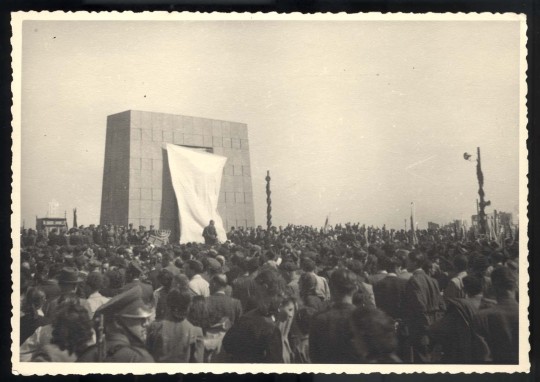
1948 unveiling of Nathan Rapaport‘s Ghetto Heroes Monument. Image courtesy of Yad Vashem.
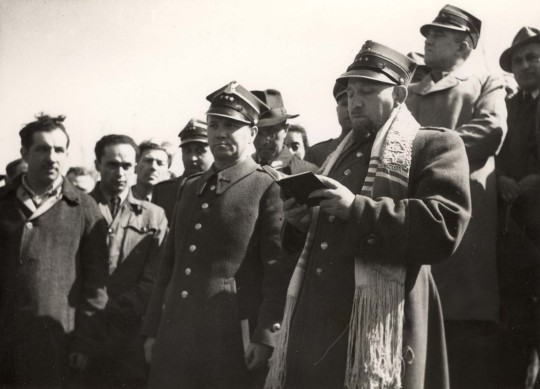
Memorial service at the 1948 unveiling. Image courtesy of Yad Vashem.

Monument close-up. Image courtesy of Yad Vashem.
In the eyes of those Poles who fought and/or supported the fight against the Nazis, this indicated nothing less than a Jewish takeover of the government, intended to suppress all memory of Polish action and oppression under Nazi rule. This led to a period of what was perhaps the worst anti-Jewish violence in the history of Polish-Jewish relations.
Between 1944 and 1947, Poles murdered between 1,500 and 2,000 Jewish survivors as they returned to their homes. Poles bombed the few remaining Jewish institutions in the country, and perpetrated pogroms against their Jewish neighbors. In Kielce, July 1946, a Polish mob attacked a communal residence set up for Holocaust survivors, murdering 42 and wounding more than 100 people. After the Pogrom, many Jewish survivors—like Vladka and Benjamin—concluded that they had no future in Poland, and left. The Jewish population of Poland shrank to under 80,000 individuals. When the government sentenced the perpetrators of the Pogrom to death, Poles protested, arguing that the Pogrom and others like it had been nothing more than Zionist plots to stimulate Jewish emigration. Anti-Semitic violence continued through the 1950s. Between 1956 and 1960, another 40,000 Jews left Poland. By the 1960s, only 30,000 Jews remained.
In 1956, an official named Mieczyslaw Moczar began to accumulate power. A member of the Polish United Workers Party and General in the Polish People’s Army, Moczar was influential in the parts of the government which controlled the police and security forces. In the 1960s, he became leader of the state-controlled veteran’s association, the Society of Fighters for Freedom and Democracy (the Związek Bojowników o Wolność i Demokracje, or, ZBoWiD), an organization with at least 300,000 members. At the same time, Polish political culture was moving away from the hard-line anti-Nationalist Stalinism of the 40s and 50s, to a climate more open to Polish nationalists. In this new climate, veterans of the Armja Krojowa and similar were now able to assert themselves in public. They took up government positions, many of them in the same departments which fell within Moczar’s sphere of influence, and, as the changing climate moved to the ZBoWiD, its ranks swelled as it opened membership to all veterans of Polish organizations which fought the Nazis.
Through his roles in the government, and in the ZBoWiD, Moczar built a power-base for himself made up of newly accepted and emboldened Polish nationalists and Home Army veterans. With this base, called the “Partisans,” behind him, Moczar launched a campaign to take control of the memory of the war years, pulling it from the custody of the earlier hard-line Stalinists into the hands of the Polish Nationalists. This meant pulling it away from a body which emphasized the plight of the Jews, to a body desperate for recognition of Polish action and victimhood.
The campaign began in earnest in 1966. In that year, the prestigious Wielka Encyklopedia Powszehna, the Great Universal Encyclpedia, printed an article which differentiated between Nazi labor camps, in which prisoners were worked to death, and death camps, which existed solely to exterminate prisoners, the majority of which were Jews. The state-controlled press picked up on this, and pundits from every corner of the country were incensed. They accused the Encyclopedia staff of erasing the history of Polish victimization during the War, while emphasizing suffering of the Jews. As a result of the controversy, a new article was printed, this one presenting all Nazi camps as inherently similar, and all existing to murder all victims equally.
In June 1967, days after the Six Day War, Polish leader Wladyslaw Gomulka, having noted that some of Poland's Jews seemed excited about Israel’s victory in that conflict, made a speech warning of the presence of a “fifth column” in Poland.1 A little over a week later, he made a speech which containeing references to the consequences of the presence of a people with “two souls and two fatherlands” within Poland. The result, as intended, was a widespread perception of Polish Jews not as Poles (not that they every truly were viewed as Poles), but as untrustworthy “Zionist” agents. In 1968, an official named Tadeusz Walichnowski, one of the leaders of the Nationalist faction of the Polish United Workers’ Party, published a highly influential, best-selling books called Israel and West Germany.

The book.
In this book, Tadeusz Walichnowski accused the State of Israel of committing genocide under the tutelage of 1,000 former Nazis. This relationship between the Nazis and the Zionists, he argued, dated back to the pre-war years. The Zionists, he continued, needed the Holocaust to happen in order to build support for the creation of a Jewish State, and collaborated with the Nazis to make it happen. Therefore, the real victims of the Nazis were the Poles, while the Holocaust had been nothing more than a German-Jewish, I mean ”Zionist,” conspiracy against the Poles.
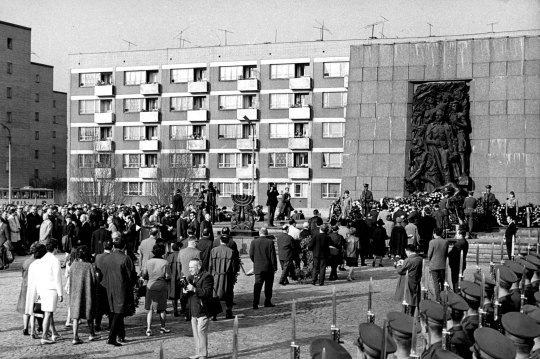
Ceremony marking the 25th anniversary of the Warsaw Ghetto Uprising, April 1968. Image courtesy of Yad Vashem.
In March 1968, in a seemingly unrelated turn of events, the government banned a production of Adam Mickiewicz’s play Dziady, due to perceived anti-Soviet themes. Students at Warsaw University went on strike in protest, and the police—rife with Partisans—came down hard on the protesters, jailing or exiling many of them. Seizing on the moment, Moczar made his move. Taking the rage of 1966, the “fifth column” fear mongering of 1967, and the conspiracy theories of 1968, he tied them all together, and placed the blame for the student protests on Zionists.
In his framing of the situation, these Zionist agitators were representatives of an anti-Polish conspiracy in which agents, both at home and abroad, actively worked to to mutilate the memory of the war years, defame the actions of the Polish Nation, and erase wartime Polish martyrdom. Major actors in this conspiracy, he argued, included West Germany, historical institutes in Israel, and centers of “Zionist” activity in the United States—you know, like the organizations Vladka worked with while giving Holocaust lectures. Under Moczar’s leadership, police and security forces instituted a search for Polish officials of Jewish descent. Tadeusz Walichnowski created a card index of all those in Poland of Jewish descent, using a system potentially stricter than that used in the Nuremberg Laws to determine descent.
Beginning in March 1968 and continuing through 1970, across Poland Jewish employees were “unmasked” and dismissed from jobs. Afterwards, it was impossible for them to find work in Poland. Further, these Jews were only allowed to leave Poland under the condition that they give up their Polish citizenship. From there, the government gave them only one thing: an exit permit valid only for travel to Israel.2 As a result of this expulsion-in-all-but-name, another 20,000 Jews left Poland. The Partisans perceived this as “proof” of the Jews’ true, Zionist, allegiance.
The legacy of the Anti-Semitic Campaign lasted through the mid-1980s. In accounts of the war published between about 1968 and 1985, the fate of Polish Jewry during the war was presented as indistinguishable from that of the Poles. Even the Warsaw Ghetto Uprising was discussed only in the context of Polish aid rendered to Jewish fighters.
By the late 1970s, early 1980s, there was a new generation in Poland, one removed enough from the war that it could look back on Polish history not as something personal, but as something to be learned. Slowly, students and members of the intelligentsia became interested in Jews, Judaism, and Jewish History in Poland. The silence of the post-1968 era was replaced with a collective interest in a long-gone, multinational Poland past. This younger generation of Poles fely comfortable mourning the Jews, and Polish historians and intellectuals felt as though they were able to engage in dialogue with their Jewish and Israeli counterparts. However, this was not simply the product of a generational shift. In Ocotber 1978, Pope John Paul II, born Karol Jozef Wojtyla in the Polish town of Wadowice, ascended from Archbishop of Krakow, to Pope. During his tenure as Archbishop of Krakow, he had been an important figure in parts of the Catholic community interested in learning about Jewish culture and history in Poland.3 As Pope, he visited Auschwitz and spoke specifically about Jewish victims of the Nazis, identifying them not as enemy nationals, but as the older brothers of the Catholic people.4 He pushed for interfaith dialogue, and remembrance of the specific Jewish experience of World War II.
In 1983, the Polish government, now long past the anti-Semitic campaign, and operating in a new atmosphere of inquiry and dialogue, arranged an elaborate commemoration of the 40th anniversary of the Warsaw Ghetto Uprising. The government invited thousands of Jews and Jewish organizations to attend. However, Marek Edelman, the last surviving leader of the ZOB, called for a boycott of the proceedings, arguing that Poland's martial law and censored press went against everything the Uprising stood for. A state-organized mass commemoration of the Uprising, therefore, could never be anything more than a propagandic farce. As a result, an unofficial memorial ceremony was organizaed, with Edelman’s blessing, to take place a few days before the government’s. Several hundred people attended. Standing before the monument, they made and listened to hurried speeches, laid flowers, and said Kaddish. And then they were dispersed by riot police.
Days later, in front of an audience of thousands, a Military Guard of Honor laid a wreath at the base of the monument to the Warsaw Ghetto Fighters.

1983 memorial ceremony. Image courtesy of Yad Vashem.
This is not where the story of the Polish relationship with Holocaust history and memory ends, but that’s where I’m going to end the the present discussion. Because, in January 1978, right before new forces took hold of the the memory of Poland's Jewish past, Vladka and Benjamin returned.
about me ask me a question twitter
1 The “fifth column,” for those unfamiliar with it, is a form of xenophobic, racist, and otherwise bigoted rhetoric used to target minorities, immigrants, refugees, outsiders, and anyway else deemed unworthy of membership in the nation-state. As applied to Jews, it cast them as inherently untrustworthy, loyal to each other (“International Jewry”) over any state in which they resided. It led to a lot of scapegoating during the Dreyfus Affair, the aftermath of the Franco-Prussian War, and the Hitler-era American nativist line that Jewish refugees were German spies. After 1948, the trope shifted to convey that Jews living anywhere outside of Israel were loyal to Israel before all else. To illustrate how this works, allow me to give you an anecdote: at a grad school happy hour I toasted “l’chaim” before downing my shot. A colleague across the table sneered at me and toasted “Free Palestine” before downing his shot. This colleague was making assumptions about my politics and loyalties as a Jewish person despite knowing nothing about me or my politics. This is fifth column thinking. And then, of course, there's our best friend, the cab driver. This all dovetails nicely with Jewish Conspiracy, and Protocols of the Elders of Zion type shit. To provide examples of how this applies to other groups, the 45th President of the US likes to insinuate that all Hispanic immigrants represent MS-13, and that all Muslims are anti-American terrorists. This is fifth column rhetoric in action. It's gross and highkey ethnic-cleansey. 2 Subtweeting all of Eurasia and North Africa here okay like if you hate the State of Israel and do not want it to exist, then maybe don’t kick out your Jews and/or treat them so horribly that their only choice is go to Israel as a result of international immigration policies/your fucking exit permit???? I mean, I know why, but... 3 In the late 1970s, liberal, educated classes of the Polish Catholic community began to take an interest in Jewish history in Poland. One of their organizations, the Warsaw Club, organized annual Weeks of Jewish Culture. On these Weeks, they would pay visits to the Jewish cemetery in Warsaw and work on restoring its tombstones, attend lectures on Jewish culture, and participate in similar activities. 4 There's a whole clusterfuck involving a convent opening in a former Auschwitz gas chamber because Lol Memory, but that happened outside of the 1946-1983 time frame of this post, so that's a memory clusterfuck I will not be discussing here.
54 notes
·
View notes
Text
Palestine - Israel ethno-religious conflict (1948 to present)
Beginning in 1923 with the destruction and subsequent carving up of the ottoman empire by european imperialists, what is now israel was planned to be used as a method to project british power around the middle east by appeasing jewish groups via the creation of a jewish homeland, hoping that in turn jews would show favour to imperial britain.
In 1948 palestine was again carved into pieces, this dictated what parts were an arab state and what parts were a jewish state, however this meant that the jewish minority now owned over half of palestine, and now the arabs owned very little land fit for agriculture.

This initiated 54 years of conflict since, some movements wanting an independent palestinian state, such as hamas or complete anhilation of the israeli state and jews, such as the islamic jihad movement in palestine.
Apartheid, preventing worship, airstrikes on civilians are all still commonplace, this year 70,000 palestinians praying at the Al qasa mosque at the final prayers of ramadan clashed with riot police sent there, (al qasa mosque is controlled by israel despite being a historical muslim/arab place of worship) this then escalated into riots in arab majority cities and a missile strike perpetrated by hamas, israel responded by airstriking a residential tower.
Rowandan genocide (1994)
The beginnings of the genocide began as a result of colonial germany favoring the tutsi minority over the hutu majority, due to the belief that tutsis were more white or otherwise simply superior, leading to animosity between the groups, however the beginnings showed when missionaries viewing themselves as the white saviours of the oppressed hutus began to create a new class of intellectual elite clergy, forming the basis of a anti-tutsi movement. Soon after murders followed and the establishment of a hutu state, though unsatisfied, preparation for the genocide began in 1990 with the military training hutu men in combat and giving out basic weapons to civilians, finally with the death of then prime minister Juval Habyarimana, allowed the formation of an emergency military junta.
Immediately after which the following year would see the systematic deaths of 1,100,000 total, most being tutsi, some being twa, moderate or sympathetic hutu and a few reporters and foreigners.
Rape squads consisting of HIV carrying men spread the then incurable slow death of HIV, men were raped, though women were worst off, 250,000 - 500,000 estimated women were raped, many hutu women also were targeted, with both sexes having their genitals mutilated.
Asian hate crimes (2019-present)
Recently the world has seen a surge of hate crimes directed at the asian race, in the uk the rate of hate crimes rose 50% in the last two years, in america it rose by 76%, seemingly due to the belief that asian peoples are infected, or somehow bare the responsibility for it, similar to those around homosexual men and AIDS/HIV or larger historical sentiments around refugees infectiousness.
However the counter movements have been quick and the “stop the asian hate” movement now exists to counter these racists and protest or otherwise demonstrate to show the strength of their community and help publicize the issue.
Kosovo - Serb ethno-nationalist conflict (1994 to present)
Kosovo gained independence out of an ethnonationalist group called the kosovo liberation army, which itself only exists due to the serbian oppressors targeting the albanian people and culture, resulting in albanian civil disobedience and the creation of albanian run educational, medical and governmental structures creating the conditions for the free state of kosovo to exist.
However, the new borders that kosovo had included a northern serbian majority, this posed an apparent threat to the government of kosovo, perhaps fearing they may want to reunify with serbia they began to oppress their old oppressors, with attacks on serbian cultural sites such as churches and even the ‘yellow house’ organ harvesting operation which killed 300 serbs.
Though there are plans in the brussels agreement to allow serbs their own police force and courts, as well as calls from the community assembly of kosovo and metohija to create self governing territories out of serb majority regions.
1 note
·
View note
Text
The Problem With Canaries
A group of pro-Israel, anti-BDS students at a variety of college campuses issued a statement harshly criticizing the Canary Mission for hindering their efforts on campus and unjustly maligning fellow students. They wrote:
Canary Mission is an anonymous site that blacklists individuals and professors across the country for their support of the BDS movement, presumed anti-Semitic remarks and hateful rhetoric against Israel and the United States.
As a group of conscientious students on the front lines fighting BDS on our campuses, we are compelled to speak out against this website because it uses intimidation tactics, is antithetical to our democratic and Jewish values, is counterproductive to our efforts and is morally reprehensible.
This blacklist aggregates public information about students across the country under the guise of combating anti-Semitism. It highlights their LinkedIn profiles, Facebook pictures, old tweets, quotes in newspapers and YouTube videos. The site chronicles each student’s involvement with pro-Palestinian causes and names other students and organizations with whom the given student may be affiliated.
We view much of the rhetoric employed to villainize these individuals as hateful and, in some cases, Islamophobic and racist. In addition, Canary Mission’s wide scope wrongfully equates supporting a BDS resolution with some of the most virulent expressions of anti-Semitism and anti-Israel rhetoric and activity.
The ADL initially supported the students, referring to Canary as "Islamophobic & racist". Critics quickly contested what, exactly, Canary did that was "Islamophobic & racist", and a day later the ADL backed off, apologizing for "overly broad" language. I want to talk through why I think objections to Canary as Islamophobic are potentially justified. But I want to do so in what I think is a more nuanced and specified way, because there really are interesting questions here regarding the ethics of counter-antisemitism (or counter-racism, or counter-Islamophobic) discourse that I think are being elided in the usual rush to back our friends and lambaste our enemies. Let's stipulate for sake of argument that Canary doesn't use specifically Islamophobic rhetoric (in the form of racial slurs, conspiratorial claims about creeping Sharia, and the like), and that in general the factual claims they make about the targeted persons (that they did say X or join group Y) are factually accurate. I'm open to the possibility that they do use such rhetoric or that their claims aren't factual (in which case the argument that they're Islamophobic becomes trivially easy). But I make the stipulation because the case I'm going to make doesn't depend on any such behavior by Canary. Instead, let's focus on what we might think of as Canary's strongest possible foundation: factual revelations of things the profiled individual has definitely said, or groups they have definitely joined, absent any additional commentary. Again, I'm not saying that this is, in fact, all or even most of what Canary does -- I'm saying that this sort of thing would presumably represents the formulation of Canary's mission that would be most resistant to a claim of Islamophobia. So. First, I do not generally think it is a smear or otherwise wrongful to simply republish a terrible thing somebody has said (with appropriate caveats about not taking things out-of-context, omitting apologies, etc.). For example, the other day Seth Mandel accused me of a "smear" and a "lie" towards him in the context of my column on sexist responses to Natalie Portman not attending to the Genesis Prize. The irony of Mandel's complaint was that he was actually never mentioned in the column at all; he only appears in the context of two of his tweets being republished, verbatim, with no additional commentary or interpretation directed towards him whatsoever. If you can be "smeared" simply by quoting your own words back to you, then I suggest that the problem lies inward. Moreover, I'd suggest that there actually is something important about revealing the prevalence of antisemitism that exists amidst certain social movements (on campus or not) -- if only because Jews are so frequently gaslit on this subject. Just this week, the Interfaith Center at Stony Brook University had to release a statement (cosigned by a wide range of campus Jewish, Christian, and Muslim groups) in solidarity with campus Hillel after a campus SJP member demanded that Hillel be expelled from campus and replaced with "a proper Jewish organization" (proper, the student confirmed, meaning anti-Zionist). This blog had already covered the Vassar College SJP chapter distributing literal (1940s-era) Nazi propaganda about Jews. These things happen, and there's something off-putting about claiming that it's a form of cheating or a smear to document it. Too many people think that naming and shaming antisemitism is by definition a witch-hunt. That cannot be right, and we should be very suspicious of political arguments which act as if it is right, or act as if the very act of accusing someone of antisemitism (or, for that matter, racism, or sexism, or Islamophobia) is dirty pool or foul play. So what accounts for my unease? Well, for one it might be the sense that college students, in particular, often say dumb things they regret, and there shouldn't be an entire website dedicated to spotlighting them and inviting people to berate them for it. How much one sympathizes with that point would seemingly correspond to how much one dislikes "call-out culture"; if you're not a huge fan of it (especially when it comes to young people not otherwise in the public eye) then Canary would seem to be one manifestation of a generally malign social trend. Another basis for objection might be the distinctively chad gadya character of many of Canary's entries. If one reads the site, very frequently a profiled individual is listed because he joined a group which hosts a speaker who supports an organization who bit the cat that ate the goat ... and so on. There's a very distinctive "guilt-by-association" character to what Canary does that I think is obviously objectionable, regardless of how you label it. And note how it resonates with the way blacklists are being deployed against Jews and Jewish groups right now (e.g., the announcement by several NYU student groups that they were boycotting a bevy of Jewish organizations -- including the ADL). Such calls very frequently proceed by similar logic: the group supports a program which hosts a speaker who said a thing ... so on and so forth. Such logic could be used to ensnare essentially anyone who affiliates with anything -- which means in practice it must be deployed selectively to delegitimize certain groups and causes under the guise of neutral idealism. If that stunt makes us uncomfortable when it's deployed against Jewish groups, it should make us uncomfortable when it's deployed against Muslim groups. And here is where I think the Islamophobia charge has legs. I don't want to say "imagine if this were done to Jews", because it is done to Jews (albeit perhaps not in quite as organized a form). But there absolutely are cases of blacklisting Jewish students simply because they've joined pro-Israel groups, without any claims that the student has said or done anything remotely racist or Islamophobic. And such behavior I think is rightfully thought of as deeply chilling, and striking too deep in terms of the way it polices to the letter Jewish political and communal participation. Many Canary entries seem to be based entirely on groups the individual has joined (everything from Students for Justice in Palestine to the Muslim Students Association -- the latter of which, it is worth noting, joined the letter in solidarity with Hillel at Stony Brook), rather than any specifically antisemitic things that the individual has said or done. That seems to be as dangerous as equivalent blacklist efforts targeting Jews who are part of Hillel, or Students Supporting Israel, or J Street (yes, J Street). Indeed, I could go further. Let's take the case of the students who have, themselves, said antisemitic things -- they're on the record. Surely there could be nothing Islamophobic about including them in a database? Yet even here, I'm conflicted -- and again, the mirror-case involving Jews perhaps reveals why. Imagine there was a website which cataloged people -- mostly, though not exclusively, Jews -- who were members of Zionist or Zionist-affiliated groups for the purpose of declaring to the world that they were racist and should not be worked with. Wouldn't we view that as being antisemitic in character? Suppose that it limited itself solely to those persons who had engaged in Islamophobic remarks -- with the goal of showing the degree to which Islamophobia and racism were prevalent in Zionist discourse, in a way that gave the impression that such views ran rampant amongst (Zionist) Jewish college students. Could that be viewed as antisemitic? My instinct is yes. It is an instinct that is, admittedly, at war with my above acknowledgment that documenting the real and non-negligible existence of antisemitism that exists in pro-Palestinian movements is not a form of cheating (and I'd likewise agree that documenting the real and non-negligible existence of Islamophobia that exists in Zionist movements is likewise not wrongful). But in both cases it is a delicate thing, lest the impression be given that Jews Are The Problem or Muslims Are The Problem. It isn't wrong to demand that groups be attentive to that possibility and work proactively against it, and it isn't wrong to be suspicious of them when they seem indifferent to it. What was it that Maajid Nawaz said? “Who compiles lists of individuals these days?" Of course, the answer is "many people and many groups," and maybe that's not per se wrong (or even avoidable). But certainly it is something that requires considerable care and concern, and Canary -- given its propensity for guilt-by-association, given its wide sweep, and given the range of individuals it includes under its ambit -- doesn't strike me as expressing said care and concern. Is that Islamophobic? Depends on how you define it, but I would suggest that there is a prima facie case of a sort of moral negligence directed at Muslim students. In other circumstances, that same sort of moral negligence impacts Jews. Either way, it's a wrong, and it's entirely fair to label it as such. via The Debate Link https://ift.tt/2r7Rd2y
13 notes
·
View notes
Text
Borders have become invisible borders, situated everywhere and nowhere.
Author/ Chi Chu
Under globalisation, which is one presentation of modernity, it seems natural to have free movement of people without borders. In this era, the transformation of transportation, technologies and cultures has enhanced people’s ability to think beyond borders and to cross them frequently (Urry 2007). Also, globalisation has created a transnational network between different nation-states and ethnic groups. However, reflecting on the concepts of contemporary nation-states and ethnic groups through modernity, ‘crossover’ is a crucial challenge under the hegemony and biopower of borders. The observation is that ‘the process of migration racialises Other and reconstructs colonisation’ (Rodriguez 2018) as insiders and outsiders are defined. The critical dilemma is ‘the visible and invisible border’, which presents how the hegemony and power of nation-states and ethnic groups not only enhances the distinction or disparity in territory and races, but also embodies the invisible borders affecting peoples’ bodies, movements and rights — a dehumanised treatment. Hence, this writing will attempt to argue ‘borders have become invisible borders, situated everywhere and nowhere’. The first part will discuss the definition of the border. Secondly, through several cases in Israel-Palestine and Europe, it will re-examine how the migration policies and biopower (Foucault,1978) of nation-states or supranational unions create visible and invisible borders in terms of movements, residence and citizenships. As a result, those policies lead to the imprison of migrants’ bodies and the denial of their sovereignty and create ‘particularistic conceptions’ (Dvir, et al. 2019) in society. Before addressing the conclusion, it also will discuss ‘border thinking’, as a transposition method, to reflect the possibility of decoloniality.
It is important to define and discuss what a border is. A border is a line that divides or divided one country or place from another (Cambridge Dictionary 2019). As Anderson (1997) states, the borders between nation-states are fundamental to politics, since without borders society and politics are difficult to dominate. Therefore, the formation of borders refers to the interests, unique power and identity of a nation-state. In response, Delaney (2008) mentions that borders between territories create not only interiors and exteriors but also distinctions between citizens and foreigners. Hence, borders represent the power to distinguish between self and others. As Malkki (1992) states, the world is represented by a collection of ‘countries’ on most world maps and rooted by different ethnic groups in every proper place, and therefore, one country structured by ideologies of nationalism cannot, at the same time, be another country.
However, a question that follows is what other reasons are there for this kind of distinction of groups beyond the geographical border? According to Barth (1969) in Ethnic Groups and Boundaries, a group is defined by the excludability and belongingness between individual groups. Groups usually emphasise specific cultural characteristics to confine the boundaries of ‘our group/self’. It means that groups’ boundaries tend to create distinctions with others and these boundaries are social boundaries instead of geographical borders. Nevertheless, cultures and society are not reflected bythe geographical space of nation-states (Gupta and Ferguson 1992). It means that space is neutral, and is inscribed by cultural differences, historical memories and social institutions. Furthermore, ‘the views of transnationalists point out that peoples interpenetrate in each other across the world, which makes the relationship between boundaries, nationalism and emergent identities be problematic’ (Shami 1996:18).
Not only do visible and invisible borders divide the land, peoples and nation-states, but the associated restrictions imprison people’s bodies and individual sovereignty. The significant observation is that the intersectionality of racism and capitalism generates migrant policy which is ‘a biopolitical tool of governance’ (Rodriguez 2018:21). Two examples of migration will now be examined, firstly, in Israel/Palestine and, secondly, in Europe, to present the intersectionality between the restriction of ‘movement’ and the challenge of ‘living/ surviving’ through the visible and invisible border.
I: Daily basis in Palestine
Currently, between the territories of Israel and Palestine West Bank, tens of thousands of migrants cross checkpoints and the separation barrier every day, which produces geographic fragments in Palestine and Palestinians’ life. Therefore, this part of the essay will discuss visible/ invisible borders under colonialization through Puar’s (2017) writing on ’will not let die’ and other individual experiences in Palestine.
During my travels, the most memorable encounter while crossing the border between Israel and Palestine was of the checkpoints and separation wall. Borders classify the land and peoples through the rule of migration because ‘migration policy is as a biopolitical tool of governance’ (Rodriguez 2018:21). Hence, the territorial configuration and policies of the nation-state affect people’s movement and generate the distinction between insiders and outsiders, and, consequently, privileges specific ethnic groups. To dominate outsiders, the encoded identity of the nation-state tends to be an existent contradiction of globalisation and mobility, and a cause of ethnic cleavage. One observed instance is that Palestinians classified by differently coloured identity cards have unequal rights. ‘I desire to revisit Jerusalem, but it is still tough’, Palestinian M (2018) — who has a Green ID — said to me. The geographical border between Israel and Palestine controls or leads to the deportation of Palestinians with Green ID cards, resulting in the imprisonment of individuals without freedom of movement. Even though individual movement ought to be a universal right, deportation is a tool used by nation-states to control mobility and people’s movement and reaffirm the formation and reproduction of citizens and outsiders (Anderson, et al. 2011). Another example is that over decades, as a result of separation and a loss of sovereignty due to manipulation and domination, restricted time and distance have caused disable mobility. It means that ‘space is shrunken, as people are held in place, rarely able to move far’ (Puar 2017:136). Therefore, visible (physical) borders, such as the separation wall and coded identity cards, have restricted on people’s movement and bodies and unequally classified rights for different ethnic groups.
As Rodriguez (2018) states, the process of racialising the Other through migration reconstructs colonisation. The norm of citizenship is also a form of expanding control at the border and building the national ideology among citizens. It evokes a discussion about the differentiation of citizenship and race, considering insiders and outsiders. Hence, an essential question arises: who has the rights of habitation as a citizen? Whether in Israel or the Palestinian territories, inspections are frequently forced on Palestinians, who are suspected of being illegal residents without documents. ‘You never know when the police will knock on the door, check your refrigerator and your identity card, suspect your right to live in Jerusalem and ask you to leave only because of the Palestinian identity’, said Palestinian I (2018). ‘In this holy place, identity documents are more important than religious credentials’, said Palestinian O (2019). It means that you will be erased from the population register once an identity card is lost. A place or house is a territory and an ‘assembly of space, power, meaning and experience’ (Delaney 2008:7). External interference forces Palestinians to unroot their sense of belonging from their meaningful place, which was historical Palestine. This has been an attempt to dominate Palestinians in terms of demography, citizenship and geopolitics by Israel. Thus, over decades, this situation has continuously happened in Palestine or among Palestinians, resulting in a significant binary, i.e. the ideas of citizens (insiders) and outsiders (migrants), embedded within social relations and melded by the perennial implications of colonial power (Rodriguez 2018:35). Unequal citizenship causes the imprisonment of the body because of a loss of home.
Moreover, for Puar (2017:52), ‘the injure of Palestinians by Israel is for stunting, physical, psychological, and cognitive injuries but not for death. It means that this biopolitical tactic attempts to make feeble any future resistance’. This kind of tactic implemented by settler colonialism damages the support system of a colonised or occupied country and results in the permanent disability of a nation. It means that Palestine has no sovereignty itself and the lives of Palestinians are defined as ‘the deployment and manifestation of power’ (Mbembe 2005; cited in Berlant 2007:755). Nevertheless, because of the maximised exploitation by a coloniser or occupier, to survive or promote the ideology of individuals and society, the status of the half-living and the imprisoned body tend to resist and rebel through political propaganda, violent activities and demonstrations. Those actions are still ongoing against biopolitics, inequality and visible/ invisible borders.
II: Migrants, refugees and asylum seekers in Europe
‘A better life’ (Utopia) is an essential motivation for migrants and refugees. In recent decades, migrants have left their motherlands because of conflicts and economic factors to seek better opportunities in Europe. Therefore, currently, over two million migrants, including refugees, have brought the European migrant crisis (Dvir, et 2019:208). Malkki states that refugees fall into the narrow slits between borders, between societies and between cultures (cited in Shami 1996:7). Hence, the second instance examined in this essay will present migrants’ individual experiences regarding the crossing of ‘visible’ and ‘invisible’ borders in terms of geography and culture ,and features ethnography from Andersson (2014), Pai (2018) and others.
The governments or nation-states are necessary for capturing the overall picture of the so-called European migration crisis. After World War II, the discourse of universal human rights was created, became the mainframe of politics and resulted in the formulation of the Universal Declaration of Human Rights and the Convention Relating to the Status of Refugees (Olick 2007:123). However, in present-day Europe, there is a contradiction between the concept of free movement for migrants and refugees, and the impact of exclusionary policies due to the European migration crisis. First, the reason for exclusion is inflamed by the migrant crisis. There is an article on Al Jazeera, Why Al Jazeera will not say Mediterranean ‘migrants’ written by journalist Barry Malone in 2015, which mentions that the terms ‘migrants’ and ‘a swarm of people’ refer to refugees in a harmful way and cause panic within the public. This language provokes a series of controversy and the notion that Europe is being overrun and plundered (Pai 2018:47). Moreover, another reason for exclusivism is that racialism and anti-terrorism play critical roles in classifying migrants and enhance anti-immigration in mainstream migration policy in Europe. For instance, “in the Netherlands, Geert Wilders, who is the head of the Freedom Party (PVV) has said Europe should close its borders, described the arrival of refugees as an ‘Islamic invasion’, and called Moroccan migrants ‘scum’” (Cited in Ibid:11). Hence, inflammatory and exclusivism distinct internal and external, and, consequently, the fundamental human right of free movement is dominated and exploited by western priorities. Migrants and refugees are not permitted freedom.
Besides anti-immigrant, vested interests profiteer from migrants through transnational institutions or agents/brokers. Individual migrants become a lucrative proposition (Ibid:iii). Aspects of the Common European Asylum System (CEAS), such as the ‘hotspot approach’ and outsourcing system, have led to malpractice, profiteering and exploitation of migrants and refugees. Several asylum seekers have not received allowances and counselling because the shelters have kept money and prefer not to spend any funds. The initial purpose of shelters has reversed, and they have become exploitation institutions. Also, the hotspot approach for frontier countries, based on the Dublin Regulation, is an identification system that uses the fingerprints of migrants, refugees and asylum seekers. However, there are attempts by migrants to avoid providing their fingerprints and seek asylum in non-frontier countries. Consequently, according to EU policy, frontier countries can force migrants to provide fingerprints through military force. It means that migrant policy as a biopolitical power governs migrants’ movements and survival.
Furthermore, agents and brokers have the chance to gain profits from those migrants who hope to obtain asylum in other countries and evade military arrest. In Syrian M’s experience in 2015 as an asylum seeker from Syria, he paid the necessary amount to agents in order to arrive and seek asylum in Germany. Compared to M, even though most migrants have the right to residence or seek asylum, they are still marked as irregular migrants and encounter deportation because of migration policies which enact the biopower of nation-states and political institutions. As Andersson (2014) highlights, ‘the making of the illegal migrant depends on the much more piecemeal endeavour of policing, assisting, and observing such travellers in Europe’s vast borderlands. Accordingly, capital and the power of nation-states or supranational unions dominate the borders and migrants.
Due to the disparity between reality and the imagined ‘better life’, the gate of civilised Europe seems not so civilised. Alberto Biondo said, ‘we abandoned the idea of freedom and be “controlled” by politics (Pai 2018:265). Therefore, the factual crisis is the disrespect towards the human right of free movement. The migration system and policies have classified peoples and embodied ‘the invisible borders on travellers’ body and the site of enforcement’ (Khosravi 2007). As mentioned above, those instances reveal the current situation, such as the exclusivism and exploitation, encountered by migrants and refugees as they seek asylum and travel in Europe. This means that free movement in Europe is based on current exclusivism and Europe is an illusory utopia for migrants and refugees. Consequently, migration policies cause the formulation of colonialism and racialism and invisible borders in society.
Despite the situations of migrants mentioned above, asylum seekers, refugees, and migrants will have opportunities to obtain relevant ‘integration courses’ and engage in local society (Hindy 2018). In response to the migrant crisis, many countries have implemented integration initiatives through several educational programs for different ethnic groups to accelerate their assimilation, eliminate the differences of individual ethnic groups and cultivate cultural diversity. For instance, in 2016 the German government announced a new policy requesting every migrant to take integration programmes on German language, history, law, and cultural norms (Ibid). This policy is based on inclusivism, and as Gupta and Ferguson (1992:35) state, “‘multiculturalism’ is a feeble recognition of the fact that an attempt to subsume this plurality of cultures within the framework of national identity”.
However, the invisible borders between individual cultures and ethnic groups are the hardest to eliminate. The first reason for this is that the essence of the ‘integration programmes’ is enhanced from top to bottom, not by spontaneous individuals. It means that those migrants will confront the end of subsidies if they do not engage the integration programs. Despite this, the programmes attempt to help migrants obtain job opportunities and engage in the German market, but there is a tendency that this market-oriented and top-to-bottom approach will likely cause resentment rather than ‘integration’ (Pai 2018:197). Moreover, the second reason is that migrants, including refugees, displaced and stateless peoples, are perhaps the first to live out reality in its most complete form when they have encountered “a generalised condition of homelessness’ (Said 1979; Cited in Malkki 1992:25). This means that there are some difficulties when integrating completely into a local society for those peoples and becoming part of a multicultural society. Hence, multiculturalism seems hard to achieve and becomes a slogan for hiding hate speech about migrants, resulting in significant controversy caused by the opposing perspectives of migration policy (inclusion of migration) and the entire society (exclusion and self-protection by locals against migrants). Also, popular and scholarly ‘generic’ representations have made the Middle East a region synonymous with conflict and war, and associated with media images of the refugee victims and terrorist perpetrators of violence (Shami 1996:9). The slogan ‘We are the people!’ (Wir sind das Volk!), which was a central slogan against the ‘Berlin Wall’ in 1989, is abused by German right-wingers to question current migration policy and accelerate hatred in German society (Huggler 2014).
A series of dissenting public voices against migration policy has caused many migrants, refugees and asylum seekers to encounter the ‘slow death’ until disappearance, which takes the form of replacement, deportation, administrative clearance or voluntary departure. ‘all this nibble at the being of the colonized tends to make life something appearing to a fragmentary death (Fanon, Cited in Puar 2017:127). It also means that nation-states, even supranational unions, tend to be unable to deal with the number of displaced people, even via integration programmes, leading to a migrant/ refugee crisis in reality. In Syrian M’s experience, after finishing the integration project, he still has pretended himself as a local and stopped praying to Allah and speaking in Arabic, and even shaves his beard because of Islamophobia. Therefore, through those actions, migrants escape racism, discrimination and exploitation and to obtain temporary rights and silence of life. This leads to the exacerbated distinction and invisible borders between different ethnic groups.
Overall, the cases mentioned above show how colonisation, inequalities and exclusivism through visible and invisible borders embody geographical distinctions and the hierarchy of ethnic groups and result in the hierarchy of citizenships, national antagonism and social differentiation. Migrants shaped by coloniality and biopower live in the border and on the border, resulting in a loss of sovereignty. The bodies and actions of migrants are incarcerated by social consciousness, and ‘the body has become the site of inscription for the politics of immigration — biopolitics of otherness’ Fassin (2001:4). Therefore, biopolitics cause the imprisonment of migrants’ bodies, and ‘crossover’ is still an essential challenge restricted by borders (colonialism). However, ‘border thinking’ (Anzaldúa 1999) is an approach that can potentially locate decolonisation and decoloniality, even though it is difficult to eliminate the concepts of nation-state or borders. Border thinking attempts to decentre the original core and re-centre peripheral visions to reverse the structure, which is related to the relationship between borders and people, including the identity of the nation-state and ethnic groups. The retransformation from bottom to top is a long process. Also, the empathy of equal human rights is critical for everyone to change colonialization and eliminate invisible borders. In short, decoloniality is a tool of reflexion and an option for rethinking how the institutions of the nation-state impact on borders and colonialism.
Reference
Anderson, B., Gibney, M. J., & Paoletti, E. 2011. Citizenship, deportation and the boundaries of belonging. Citizenship Studies 15:5, 547–563.
Anderson, M. 1996. Frontiers: Territory and State Formation in the Modern World. UK: Polity Press.
Andersson, R. 2014. Hunter and Prey: Patrolling Clandestine Migration in the Euro-African Borderlands. Anthropological Quarterly, 87:1, 119–149.
Anzaldúa, G. 1987. Borderlands/La Frontera: The New Mestiza. San Francisco: Aunt Lute Books.
Barth, F. 1969. Ethnic Groups and Boundarie. UK: George Alien & Unwi.
Berlant. L. 2007. Slow Death (Sovereignty, Obesity, Lateral Agency). Critical Inquiry, 33:4, 754–780.
Cambridge Dictionary 2019. border. (available on-line https://dictionary.cambridge.org/, accessed 19 Dec. 2019).
Delaney 2005. Territory: A short introduction. US: Wiley-Blackwell.
Dvir, Y., Morris, P. & Yemini, M. (2018). What kind of citizenship for whom? The ‘refugee crisis’ and the European Union’s conceptions of citizenship. Globalisation, Societies and Education, 17:2, 208–219.
Fassin, D. 2001. The biopolitics of Otherness: Undocumented foreigners and racial discrimination in French public debate. Anthropology Today, 17:1, 3–7.
Foucault, M. 1978. The History of Sexuality (Volume I: An Introduction) (trans. R. Hurley). NY: Pantheon Books.
Gupta, A. and Ferguson, J. 1992. Beyond Culture: Space, Identity and the Politics of Difference. Cultural Anthropology,7:1, 6–23.
Hindy, L. 2018. Germany’s Syrian Refugee Integration Experiment (available on-linehttps://tcf.org/content/report/germanys-syrian-refugee-integration-experiment/?agreed=1, accessed 19 Dec. 2019).
Huggler, J. 2014. Germans take to the streets to protest against ‘Islamisation’ (available on-linehttps://www.telegraph.co.uk/news/worldnews/europe/germany/11281103/Germans-take-to-the-streets-to-protest-against-Islamisation.html, accessed 19 Dec. 2019).
Khosravi, S. 2007. “The ‘illegal’ traveller: an auto-ethnography of borders”. Social Anthropology/Anthropologie Sociale, 15:3, 321–334.
Malkki, L. 1992. National Geographic: The Rooting of Peoples and the Territorialization of National Identity among Scholars and Refugees. Cultural Anthropology, 7:1, 24–44.
Malone, B. 2015. Why Al Jazeera will not say Mediterranean ‘migrants’ (available on-line: https://www.aljazeera.com/blogs/editors-blog/2015/08/al-jazeera-mediterranean-migrants-150820082226309.html, accessed 19 Dec. 2019).
Olick, Jeffrey K. 2007. The politics of regret : collective memory in the age of atrocity. New York: Routledge.
Pai, H-H 2018. Bordered Lives: How Europe Fails Refugees and Migrants. UK: New Internationalist.
Puar, J. 2017. The Right to Maim. Durham: Duke University Press.
Rodriguez, E.C. 2018. The Coloniality of Migration and the “Refugee Crisis”: On the Asylum-Migration Nexus, the Transatlantic White European Settler Colonialism-Migration and Racial Capitalism. Refuge, 34:1, 16–28.
Shami, S. 1996. Transnationalism and Refugee Studies: Rethinking Forced Migration and Identity. Journal of Refugee Studies, 9:1, 3–26.
Urry, J. 2007. Mobilities. Cambridge: Polity.
zeitzeugen-portal 2011. 1989: “Wir sind das Volk” — Leipzig im Oktober (available on-linehttps://www.youtube.com/watch?v=2OjCesZRf_I, accessed 19 Dec. 2019).
0 notes
Text
Is it safe to travel to Lebanon? Updated 2019
Update Lebanon September 2019: On August 25th, one Israeli drone exploded in the suburbs of Beirut, in a Hezbollah area. No people were injured and despite they were targeting Hezbollah areas, the real reason is unknown. However, this one-time incident doesn’t make Lebanon unsafe. Continue reading for a better understanding.
Today, many people are continuously asking me:
Is it safe to travel to Lebanon? Is Beirut safe?
That’s because, unfortunately, many travelers believe that safety in both Beirut and Lebanon is an issue.
But guess what! Lebanon, including Beirut, is one of the safest countries in the Middle East. The only reasons why it’s not considered as such are the media and inaccurate Government travel advice and warnings.
With one of the lowest crime rates in the world today, Lebanon can brag about having the lowest number of Islamic extremists in the Middle East. This article aims to tell you the reasons why.
In 2019, I traveled from Beirut to Syria and spent 1 week around the country. I highly recommend you read: Tips + How to travel to Syria – Everything you need to know
If you want to stay informed of all my current trips, remember to follow @againstthecompass on Instagram.
Here you will find (Jump to any content you want)
Is it safe to travel to Beirut? And how safe is Lebanon? Non-safe areas you should not travel in Lebanon Lebanon travel advice and tips on how to visit the sensitive areas of Hezbollah The isolated case of Tripoli Extra: Lebanon and Beirut safety tips
Do you know what a VPN is? A Virtual Private Network allows you to access blocked sites when you travel, as well as it lets you access content only available in your home country (like Netflix), plus it prevents hackers from stealing your personal data. Learn here why you should always use a VPN when you travel
Are Beirut and Lebanon safe?
Contrary to what people say, there is no war in Lebanon and Beirut
For some reason, people in the West tend to associate Lebanon with war. And I wonder: ”Why?” Whereas it’s true that the country did suffer 25 years of Civil War, this ended in 1991. It was more than 25 years ago!
Hey, have you ever wondered how I make a full living from blogging? Learn here how I started monetizing my blog and get over 200,000 monthly page views in less than 3 years
Furthermore, the Lebanese-Israeli war took place in 2006, but it lasted for one month only. For the past 10 years, the country has been able to enjoy peace!
Read: A travel guide to Beirut
A church destroyed by the Civil War, 25 years ago – Lebanon travel warning
In Lebanon, there’s no place for extremism. Did you know that more than 40% of the population are Christians?
Lebanon is one of the most culturally diverse countries in the world and today, several different religious groups coexist peacefully.
Did you know that more than 40% of the population are Christians? No? Did you know that Sunni Muslims (the branch of Islam that ISIS draws its followers from) only make up 25% of the population?
In this country, there’s no place for extremism. Have you ever heard of any Lebanese who has radicalized and joined ISIS? Normally, they come from Syria, Saudi Arabia, Jordan or even Turkey. Lebanon is so culturally cluttered, that the chances of a person radicalizing are low.
Read: 50 Tips for traveling to Iraqi Kurdistan
A mosque and a church built side by side – Is Beirut safe?
The most liberal country in the Middle East
On the other hand, although religion plays an important role in the life of most families, from a religious point of view, Lebanon is the most liberal country in the entire Middle East.
It has the largest number of atheists (especially among young people), beer is available everywhere and drinking alcohol in the street is allowed (and quite common). Surprised?
In December 2018, I went to Saudi Arabia because for the first time in history, they started issuing tourist visas. Read: Tips + How to travel to Saudi Arabia
It shares a border with Syria. OK, so what?
Lebanon shares border with Syria. Yes, so what? They are two different countries. The border between them is highly guarded and controlled. The chances of the Syrian conflict moving into Lebanon are non-existent.
The investment in military security is huge
We can’t forget that Lebanon is located in a highly turbulent region. The military presence aims to prevent any sort of potential conflict.
Soldiers and checkpoints are found in absolutely every corner of the country, especially in Beirut. The Lebanese people love the army. They are accepted in society because it makes them feel safer.
Read: The ultimate 10-day itinerary to Lebanon
Soldiers in Beirut – Is Beirut safe to visit?
Crime rate and kidnappings are non-existent
As in most of the Arab countries, the crime rate is practically zero. No robberies, no violence. In Lebanon, you can walk around without a worry anywhere at any time, even women.
Read: A travel guide to Palestine
NO-GO zones when traveling to Lebanon
I just told you the reasons why Lebanon and Beirut are safe places to travel to.
Does it mean that you could wander freely across the whole country? No, absolutely not.
Whereas it’s true that 95% of the country is safe, the remaining 5% might not be. Why?
Because the few radicals who live in the country are found in those areas. These areas are dangerous, not only for the simple fact that you may meet some extremists, but, since the area is so close to Syria, it also suffers from spillover from the Syrian conflict.
Where are these no-go zones? Basically, the north-eastern portion highlighted in red. Don’t even get close to this area. The rest of the country is safe. Please note that the below map is an approximation.
Update 2018: The army managed to kick out many of the ISIS troops. The security in this tiny part of Lebanon has also improved.
Safety in Lebanon & Beirut: Visiting the sensitive areas of Hezbollah
There are a bunch of areas which, even though they are not classified as dangerous, are considered sensitive. Why? Because they are controlled by Hezbollah. What does ”sensitive area” mean? Hezbollah areas have always been the target of terrorist groups, such as the Islamic State.
In fact, the last suicide bombings that occurred in Lebanon (don’t worry, there is one attack per year) happened in Hezbollah areas. They are partially restricted and no journalism of any sort is allowed.
To understand it better I recommend you read: The day I was accused of being an Islamic State spy in Lebanon
Which Hezbollah areas are sensitive?
Shia Muslim neighborhoods of Beirut, for example, Bourj el-Barajneh
Some refugee camps, for example, Ain al-Hilweh in Saida
Hezbollah territories located in the south of Lebanon, close to the border with Israel
The Palestinian refugee camp of Shatila, Beirut – How safe is Beirut Lebanon?
Things to keep in mind when visiting a Hezbollah area
Don’t even think of taking pictures or let anyone see you with a camera
Some locals may be hostile and you might be kicked out for no reason. If you have the chance to go with a Lebanese, then do it
Foreigners will always be treated as suspicious. You’ll pass through several checkpoints where you’ll be checked and interrogated over and over
In these areas, there are no tourists. Many of the residents can’t understand why someone would to come to their area for tourism purposes. Repeatedly, you’ll be asked by the locals: ”What are you doing here”? Simply, answer: ”Nothing, I am just a tourist and I am walking all around the city”.
Today, Hezbollah areas are relatively safe. I say relatively because there’s one suicide bombing per year, approximately. To be safer, stay away from crowds.
Before heading to any of those areas, check the current situation with a local Lebanese. The areas close to the Israeli border require a special permit. To get it, go to any police station in either Saida or Beirut. You will get it instantly. Keep in mind that this permit gives you access to the area, but it doesn’t allow you to take pictures or do anything silly.
Important to mention: These areas have no appeal for tourists. The only reason why you would want to go there is that you are tremendously curious and need to know what the hell is going on in there. I visited everything. In the border with Israel, I was detained by the authorities. In the Shia neighborhood of Bourj el-Barajneh, some locals kicked me out, pacifically, but for no reason. However, I didn’t experience any issues when I visited the Palestinian refugee camp of Shatila. If you are as freaky and curious as I am, the experience is definitely worth it.
Read: Visiting Bourj el-Barajneh by Offbeat Travelling
Bourj el-Barajneh (Hezbollah area) – Travel in Lebanon
The isolated case of Tripoli
The UK travel advice to Lebanon says that Tripoli is not safe.
Tripoli is a city located in the north of Lebanon and the second most important one. Why do governments consider it dangerous? Since the Civil War, there have been one-off clashes between Sunni and Alawi Muslims who reside in the neighborhoods of Bab al-Tabbaneh and Jabal Mohsen, respectively. Throughout the years, these clashes have killed several people.
This is a one-off conflict happening in a specific area, far away from the city center. It’s a fight between two small districts and doesn’t go beyond them. The rest of the city is totally cool and safe. I spent four days in Tripoli, and to be honest, it was one of the highlights of my trip.
I also have to admit that, since I’m an extremely curious human being, I also went to Jabal Mohsen. And what can I say? Life there was merely normal. Again, clashes and bombings happen once a year, not more.
Read: 80 Useful tips for traveling to Iran
Jebel Mohsen, a neighborhood in Tripoli which, according to FCO, is one of the most dangerous areas in Lebanon. However, I went there and it was just fine – Lebanon travel
Extra: Beirut and Lebanon safety tips
Consider going on a tour
I always encourage people to travel independently but I can also understand why some travelers may prefer to travel on a tour, especially in a place like Lebanon.
I recommend you book them via GetYourGuide, as they always work with a wide range of local guides and tour operators, and you can book your tour with just one click.
So far, these are the tours they offering for traveling in Lebanon:
Beirut city tour – Explore one of the most fascinating cities in the Middle East. CLICK HERE TO LEARN MORE
Jeita, Harissa and Byblos – Trip to one of the most stunning caves in the world and historical cities. CLICK HERE TO LEARN MORE
Wine tour – Lebanon is well-known for its wine and, in this tour, you will visit 3 different wineries from Beqaa Valley. CLICK HERE TO LEARN MORE
Baalbek – Some of the most outstanding Roman ruins outside of Rome. CLICK HERE TO LEARN MORE
Epic ruins of Baalbek
Stay safe by planning your trip ahead – Best books for traveling to Lebanon
The best way to travel to Lebanon safely is to plan your trip properly. For this, I recommend the following books:
Lebanon Travel Guide by Bradt – This is the most updated book guide about Lebanon. Bradt is my favorite brand because they always provide with plenty of local insights and travel tips for independent travelers.
CLICK HERE TO CHECK PRICES ON AMAZON
The Middle East Lonely Planet Guide – It has only one chapter about Lebanon but the information is updated, so it might prove useful.
CLICK HERE TO CHECK PRICES ON AMAZON
English-Arabic phrasebook – Extremely useful when you are outside of Beirut.If you can communicate with the locals, you will, of course, be safer.
CLICK HERE TO CHECK THE LATEST PRICES
Get proper travel insurance
Lebanon is safe but, truth to be said, it is not the easiest country to travel around because, like many Arab countries, things can become pretty wild.
I always recommend World Nomads. Why?
It is the only company that provides unlimited medical coverage
You can buy while you are already on the road
It covers the largest amount of adventure activities
CLICK HERE TO GET YOUR FREE QUOTE!
Use Couchsurfing
In Beirut, Couchsurfing is a big deal and there are plenty of events every week. I suggest you look up for these weekly events and get to know some Lebanese people. Actually, there is a group of local attendants who are organizing trips for foreigners almost every week.
A reminder
As I mentioned previously, don’t go to the northeast of the country and watch out when you are in Hezbollah areas.
And remember to check my other all my other guides about Lebanon:
Beirut travel guide A 10-day itinerary for visiting Lebanon Backpacking in Lebanon: How much does it cost in 2018?
For more content to the region, don’t forget to check all my travel guides to the Middle East
And don’t forget to check my Syria travel guide!
Conclusion
Is Lebanon safe? The answer is yes, but you need to keep in mind that this country has gone through several conflicts and is located in the heart of the most turbulent region in the world.
Travel safe and cautious. If you have any question, leave a comment below. I’ll be happy to answer. Cheers.
I also recommend reading: Is it safe to travel to Iraq?
If you like my website and found this post useful, remember that, if you book any product or service through any of my links, I will get a small commission at no extra cost to you. These earnings help me maintain and keep Against the Compass going! Thanks

from Cheapr Travels https://ift.tt/2l8vyIx via https://ift.tt/2NIqXKN
0 notes